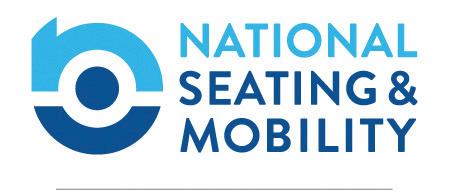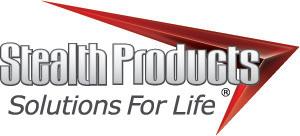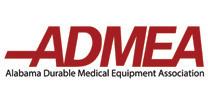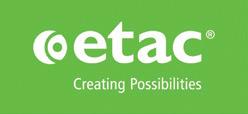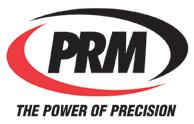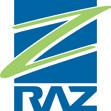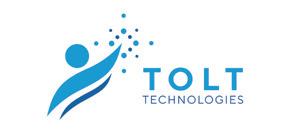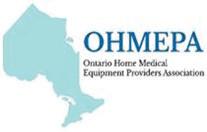
NAVIGATING GROWTH: BALANCING WHEELCHAIR CONFIGURATION WITH FUNCTION FOR THE PEDIATRIC CLIENT


NAVIGATING GROWTH: BALANCING WHEELCHAIR CONFIGURATION WITH FUNCTION FOR THE PEDIATRIC CLIENT
FROM THE iNRRTS OFFICE
Excited for the Future of iNRRTS
INDUSTRY LEADER
Greg Peek has Built Long Track Record of Success Inside, Outside Complex Rehab Industry
CRT UPDATE
August 2024 Update
NOTES FROM THE FIELD
No Turning Back: Chris Savoie is in it for the Long Haul
LIFE ON WHEELS
Life is Not a Flat, Paved Road
CLINICAL PERSPECTIVE
CEU ARTICLE
Navigating Growth: Balancing Wheelchair Configuration with Function for the Pediatric Client

REHAB CASE STUDY
Dynamic Seating – Providing Movement for Clinical Benefit
CLINICALLY SPEAKING A Decades-Long Journey in Pediatric Physical Therapy
MOMENTS WITH MADSEN The Power of Investing in Education
CLINICIAN TASK FORCE
An Update on Advocacy Actions: Preliminary Research Findings and Ongoing Collection
RESNA RESNA Update
DIRECTIONS CANADA
Sneak Peek into the World of Standards
The opinions expressed in DIRECTIONS are those of the individual author and do not necessarily represent the opinion of the International Registry of Rehabilitation Technology Suppliers, its staff, board members or officers. For editorial opportunities, contact Amy Odom at aodom@nrrts.org
DIRECTIONS reserves the right to limit advertising to the space available. DIRECTIONS accepts only advertising that furthers and fosters the mission of iNRRTS.
i NRRTS OFFICE
5815 82nd Street, Suite 145, Box 317, Lubbock, TX 79424
P 800.976.7787 | www.nrrts.org
For all advertising inquiries, contact Bill Noelting at bnoelting@nrrts.org
This issue of DIRECTIONS is chock-full of important and pertinent information. Read Carey Britton’s article and note it is his last written article as president. Carey, thank you for serving as the president of iNRRTS. We appreciate your insight and guidance. Did you know you can read DIRECTIONS online at www.nrrts.org/directions? Make sure to check out the online version.
Amy Odom, BS
EDITOR-IN-CHIEF
Amy Odom, BS
EDITORIAL ADVISORY BOARD
Kathy Fisher, B.Sc.(OT)
Andrea Madsen, ATP
Bill Noelting
Weesie Walker, ATP/SMS
DESIGN
Brandi Price - Hartsfield Design
COVER CONCEPT, DESIGN
Brandi Price - Hartsfield Design
PRINTER
Slate Group

Written by: CAREY BRITTON, ATP/SMS, CRTS®
As I write this, my final article as president of iNRRTS, I have a lot of thoughts running through my mind on what to impart and share. Although I could choose to be dark and discuss the many challenges we face, I chose to celebrate what we have done and continue to accomplish: iNRRTS continues to support and promote the value of the rehabilitation technology supplier to funding sources and medical professionals and consumers who depend on us. Other countries are seeing the need for what iNRRTS provides and stands for, and I am counting on the U.S. market to again see the current direction of Complex Rehab Technology needs iNRRTS to shine the light on the path forward.
I wish I could reach out to each assistive technology professional (ATP)/RTS in our industry to ask them, “Are you already a Registrant, and if not, why do you not see the value of becoming one?” The cost of the registration includes access to worldclass education and required CEUs, code of ethics, professional credentials, mentor network, updates on industry affairs, opportunities to impact the industry’s direction, marketing that shows the value of the RTS, advocacy, CRT improvement, and a network of likeminded people. The latter may be the best perk, as it is proven that who you become both personally and professionally is largely based on the people you surround yourself with.
I still have several years to continue my profession of CRT, and I believe the RTS, now more than ever, needs to embrace leadership. We may all work within local or national organizations, but if we do not demonstrate and share the value of what we do, the funding and business pressures will reduce what we do to a commodity. We need to be shown that what we do directly affects the outcomes of health care. We need to be guiding our companies and funding sources on the need for increased funding based on inflation and equipment innovation and evolution. We are on the front lines, listening and seeing what our clients need, which means we must require our companies and funding sources to understand. We have had some success with seat elevation and repairs/maintenance, yet, there is still work to be done.
I talk to many frustrated RTSs who throw up their hands and retreat to “doing their job” instead of
leading their teams to greatness. If we do not advocate and lead, the business side will choose our destination. If you want help improve your leadership skills, find a mentor and join iNRRTS, get involved in committees, learn to advocate and learn how to teach others to advocate for a better tomorrow.
I recognize there were many people who have imparted knowledge and support on my journey. Each day, I commit time to teaching technicians, RTSs, CSRs, clients, caregivers and medical professionals on the value of CRT as well as how to access and advocate for new equipment, modifications and repairs. I feel that giving back to the next generation ensures what iNRRTS and others in our industry perpetuated and continues.
My one challenge for us all is once you have read this article, share the message of iNRRTS with your peers, clients, medical professionals and funding sources. Always ask, “Why do you not demand a Registered Rehabilitation Technology Supplier ® (RRTS ®) or a Certified Complex Rehabilitation Technology Supplier ® (CRTS ®) to provide to provide your equipment?” If you were counting on someone to improve and enhance your seating and mobility, would you not want someone who is committed to providing the best outcomes?
I am pleased to hand the baton off to the next president, Jason Kelln, ATP, CRTS®, a Canadian. This is exciting and appropriate with the evolution from NRRTS to iNRRTS that we have the first international president. I believe his care, commitment and enthusiasm will continue to grow and further develop iNRRTS into more of a global organization; ensuring its roots and value of the RTS within the CRT process is maintained. I am looking forward to joining the past president’s group and adding value when possible. I hope I made an impact and leadership through my term and showed respect to all those who have come before me to help guide and support the direction of iNRRTS. I want to thank all the board members and staff who have continued to make our organization world class.
CONTACT THE AUTHOR
Carey may be reached at CAREY.BRITTON@NSM-SEATING.COM



Written by: DOUG HENSLEY
For Greg Peek, there has been nothing typical about the trajectory of his career. The only direction has been up, and the only way has been forward.
For the most part, he has been in perpetual motion throughout, making an impact and leaving a legacy all along the way.
Peek is president of Seating Dynamics, in Centennial, Colorado. But that’s only the latest chapter in a life devoted to working hard and making a difference as he has now spent 44 years in the wheelchair field as a manufacturing business owner.
“I never could have guessed I would be in this role today,” he said. “I had no idea where I was going during my early years, and things kind of evolved around a passion for race. The wheelchair field was just a pure accident, but after you fall in, you can’t get out.”
Before wheelchairs and becoming a self-employed business owner more than 50 years ago, Peek had two other jobs. The first was as a tool and die apprentice; the second was setting up and running a mechanical test lab for a company building pneumatic transit tube systems.
“Breaking things and figuring out why they broke was an absolute blast,” he said.
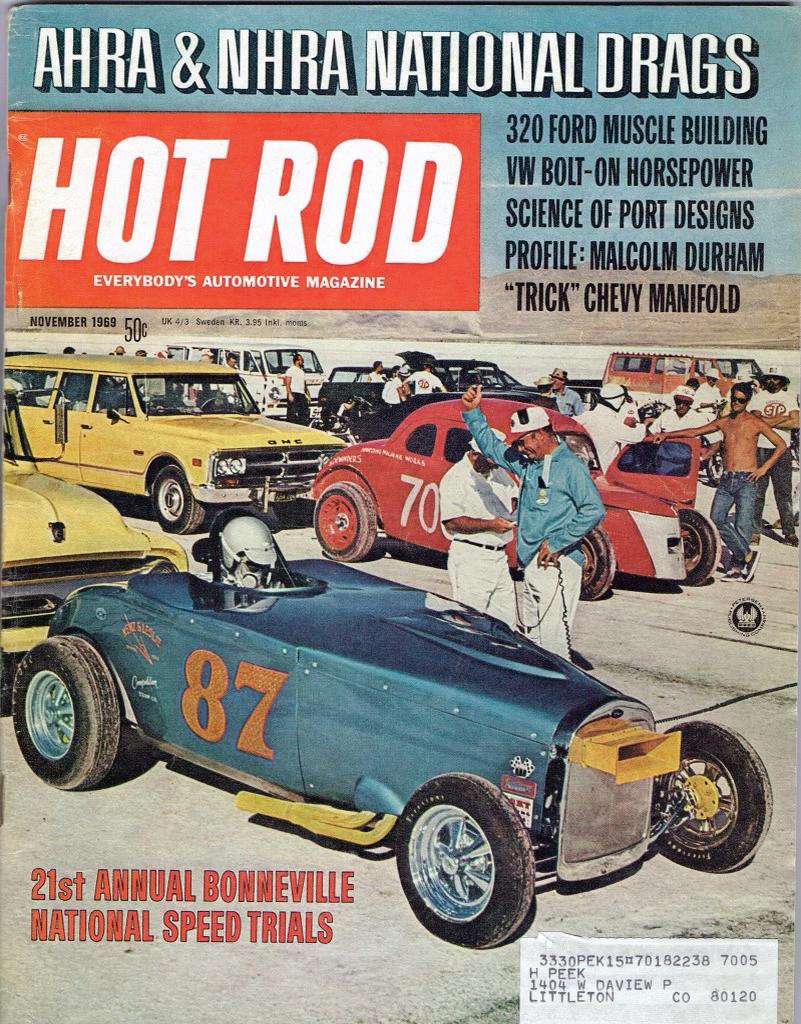
Both times, his love for racing pulled him away, but the two jobs helped him figure out what he wanted to do, and what he had been doing, working for a big company, was not it. Peek admits to not knowing that he could not do something, so just jumping into the deep end of the pool and solving the problem of not drowning became the foundation of providing solutions to complex problems.

“I think you must be passionate about something. In my early years, I was beyond passionate about race cars. I was probably obsessed with building the most advanced and nicest race car of its type. That first car has that reputation to this day.
“I never could have dreamed I would wind up in the wheelchair field, much less stay here. But here I was with the capability of answering questions and solving problems, which is what I enjoy doing more than anything else.”
And there have been a lot of career highlights along the way. Remember his love of racing? He built his first race car between his junior and senior years of high school with an updated version of the car eventually being a dedicated cover car of Hot Rod magazine just three years later.
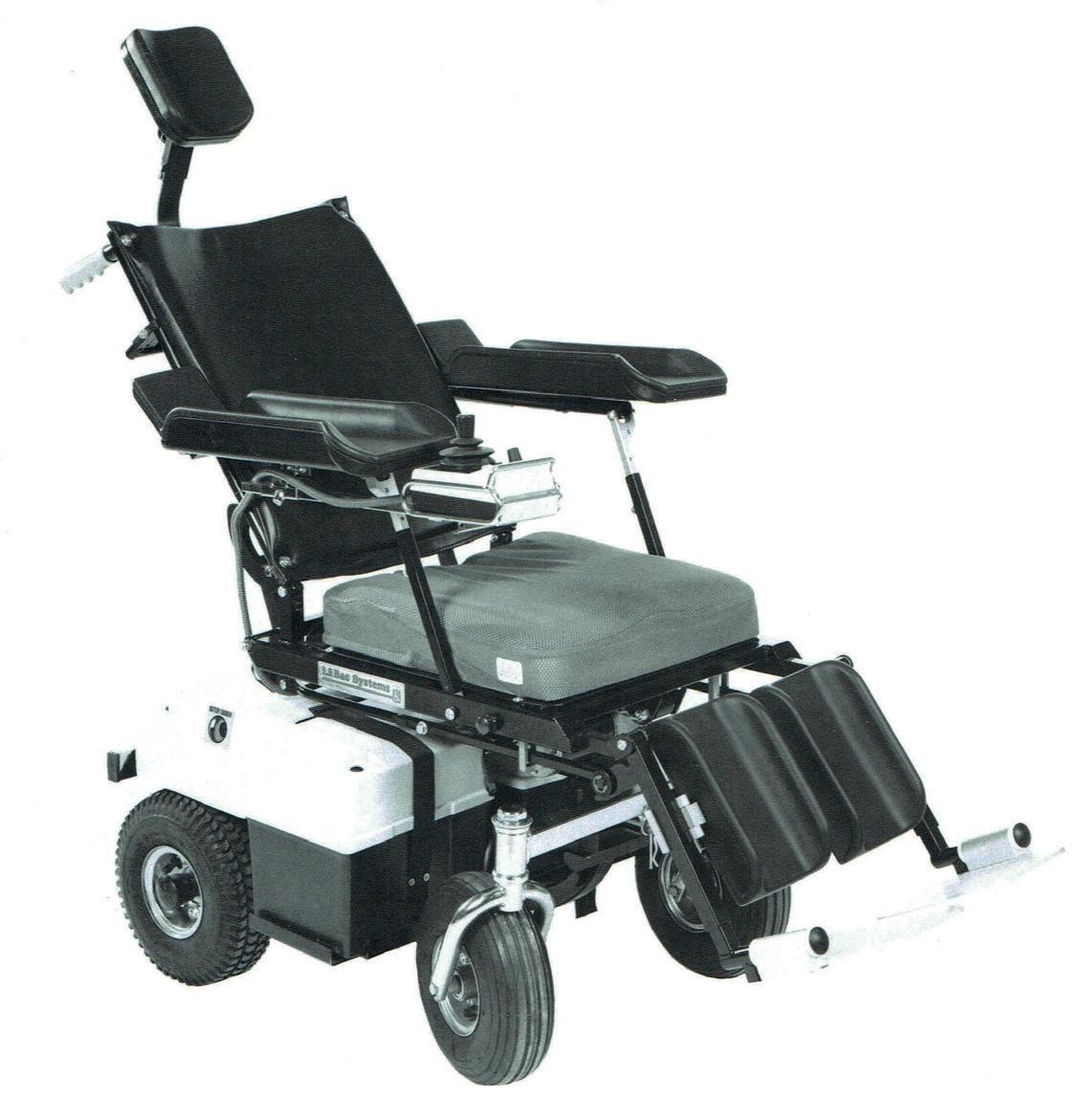
The first exposure to wheelchairs came in 1976, landing a contract with the local regional transportation district to produce 50 sets of wheelchair restraint devices which they had licensed. Then came participating in the design, of, and building the original seat prototypes for the space shuttle; producing replacement parts for military aircraft; and designing technical rock-climbing hardware.
Always searching for business opportunities, Peek met Dick Devoe, the owner of the primary supplier to Craig Hospital and one of the few stores in the country dealing in “high-quad power wheelchairs” while fulfilling the transportation district’s restraint contract.
That meeting paid off in the spring of ’81 in an annual check-in phone call with Devoe, who said, “Come over to the store. I have something to show you.”
That something turned out to be a need for a better power recliner add-on, which “raised the back post pivot point to match a high profile Roho cushion and kept the actuator from rubbing on the sling seat upholstery.”
Thirty days later the first modern and successful low shear power recline kit was delivered. Building the wheelchair restraint system for that bus company is ultimately what pulled Peek into the wheelchair business. He and his brother Michael started LaBac Systems in the early 1980s before selling the company in 1997.
“I love having the opportunity to have a positive impact on people’s lives,” Peek said. “I have worked in different fields, but I have always tried to think outside the box. The one element that has remained constant through everything I’ve done involves tubing and wheels, like race cars, bikes and wheelchairs.”
Peek has had several professional successes in the years since, some in wheelchair design and some in the race car world. Those are:
February 1983, moving beyond the low-shear recliner developed in 1981, Peek identified a need for a better recliner to eliminate shear in the back, not just reduce it. Design work started but was put on hold when life got in the way.
August 1983, LaBac Systems incorporated in Colorado.
November 1984, Peek first attended the National Home Health Care Exhibition in Atlanta, Georgia.
INDUSTRY LEADER
(CONTINUED FROM PAGE 7)
1985, Peek Exhibited at the first International Seating Symposium in Memphis, Tennessee. The bolt-on recliner kit became the drop-on recliner when a solid welded seat frame assembly converted the folding, belt drive, 24-inch rear wheel into a rigid frame chair, opening new possibilities.
1985-1986, Life got out of the way and the “Sliding Back” recliner is completed, patent applied for. The first power recliner successfully addressed shear elimination.
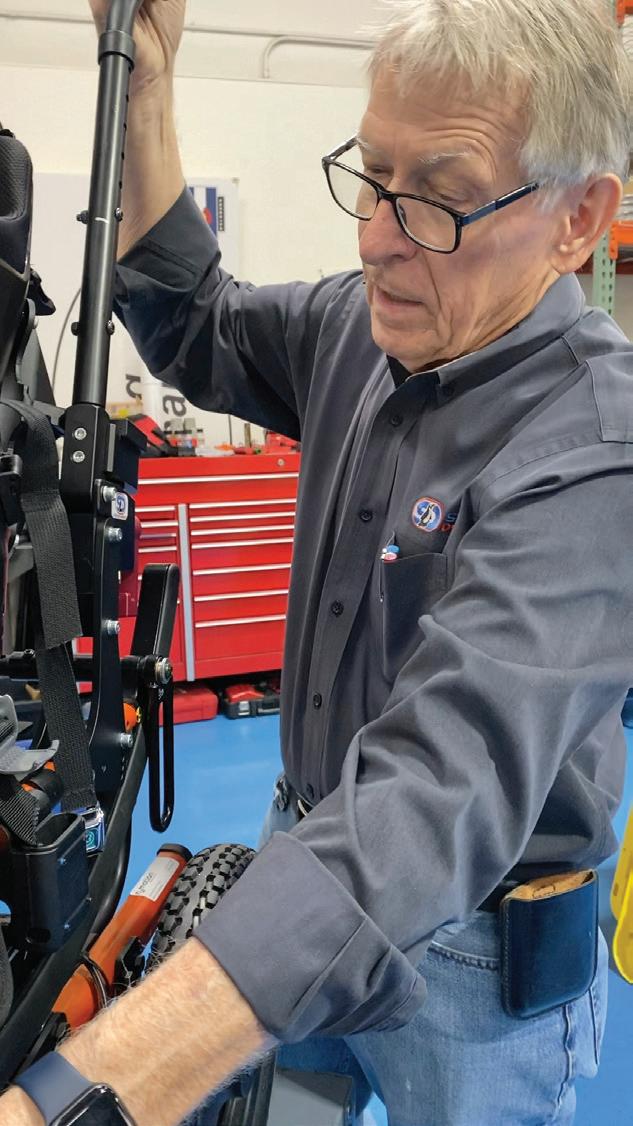
1986-1987, Introduction of the first “Power Base,” the Fortress FS-655, pushed the “Drop-On” recliner into a complete and comprehensive power recline seating system, from the footrest to the headrest and everything in between, all from LaBac Systems.
1988, LaBac Systems pushes the envelope requiring education and training in the Highlands Ranch, Colorado, training facility at the factory. It is believed that this was the first time a company required training to purchase products.
1990-1991, Designed and produced the LaBac MTC, the first adult-size manual tilt chair. This was followed by several alphabet soup variations. Designed and patented “Active Anti-Tippers” for use on short wheelbase power chairs, essentially creating a six-wheeled chair, which prevented tipping. Additionally, several custom seat elevating seats/carts for power chairs utilizing scissor lifts, predating what everyone does today.
1996, Designed and patented the Variably Adjustable Lower Body Support, also known as 4 Axis footrest, and modular adjustable seat frame for wheelchairs, a width and depth adjustable solid seat frame, which could also have functional components added or deleted to change the configuration and function of the power seat — essentially what everyone does today.

June 1997, This was a year that everyone experiences in some way, “the biggest mistake of my life” when LaBac is sold to Graham Field. The legal handcuffs and bankruptcy protection forced Peek out of the industry and held him out until April 2003.
Summer 2003, Peek moves back into the LaBac building and starts preparation for reentry into the wheelchair field, attending Medtrade later that year introducing a new line of "Degage" manual tilt wheelchairs. Probably the most robust and durable adult manual tilt chair ever made, just a little bit ugly.
2005, While exhibiting at ISS in Orlando a therapist asks, “Can you do anything to stop these “Rocker Bangers” from breaking the back canes from their chairs.” Peek, still not knowing there are things he can’t do, says yes.
Late 2005, The “Dynamic Rocker Back” is born, Seating Dynamics follows shortly thereafter, and the rest is recent history. Seating Dynamics has become and is still the only company worldwide to focus exclusively on dynamic seating components for wheelchairs.
August 2018, Designs and builds wheels enabling the "Turbinator streamliner" to become the world’s fastest and only wheel-driven vehicle to traverse the Bonneville Salt Flats at over 500 mph.
August 2021, Designs and builds the motor drive systems allowing the “Vesco Little Giant” to become the world’s fastest electric vehicle at over 357 mph.
Peek’s life has also been filled with a lot of highlights and memorable moments. The challenge comes in trying to select only a few.
“We had an incident here a few months ago with a local kid,” he said. “I don’t know all the diagnoses, but there was a 9-year-old, 37-pound boy with a beautiful little orange Zippie Iris full of our dynamic components and an Aspen ASO. The supplier did a beautiful job of assembling the chair; it was good looking, but it didn’t work.
“The chair was not working because everyone involved didn’t see the big picture. It did not fit him, and the geometry between the DRBi and the ASO was a mess. I wasn’t afraid to jump in and get my hands dirty and my feet wet. We modified the chair itself from front to back and made different pieces. When done, it fit, and he was able to move the dynamic components, now including the ASO for the first time.”
Another local mother sent comments to the Centers for Medicare and Medicaid Services in response to the recent funding reduction, she said, “Dynamic seating has changed my son’s life and probably extended his life.”
Peek said, “I am fortunate to have the opportunity to have an impact on lives like I have; most people don’t get that chance.”
Peek has seen a lot of industry challenges through the years.
“Navigating the government-imposed funding on the complex rehab industry as a whole is one of the biggest challenges,” he said. “As an industry, we seem to be helpless in trying to educate and communicate to bureaucrats who don’t listen. They act on some preconceived notion, which only protects their budget but puts the existence of entire product categories at risk of disappearing.
“My little dynamic seating niche is so small it has a microscopic impact on the CMS budget, yet we just saw a fee schedule amount go into effect, which was an 80% reduction from the industry average MSRP. We are concerned this is just the tip of the iceberg.”
As he looks ahead, Peek hasn’t slowed down at all. He is busy working to get a second company up and running, a metal finishing business specializing in aluminum anodizing, that he hopes is humming by the end of September. It’s not something he wanted but was pushed into it by the failure of other local companies’ inability to provide consistent high-quality hard black anodizing.
“Plus, I have things to do in this field as far as new ideas and new products I’m working on that the world hasn’t seen yet or even thought of. I’ve been fortunate to have a lot of opportunities and have done a lot of things. And it has been all sorts of fun.”
Greg may be reached at GREG@SEATINGDYNAMICS.COM

Written by: WAYNE GRAU
NCART has submitted an Healthcare Common Procedure Coding System coding application to formally appeal the Centers for Medicare and Medicaid Services’ decision to increase the fee schedule by $13, which was recently released. NCART made the following statement, “While we appreciate CMS’ willingness to listen to our concerns and review the follow-up information we provided, they indicated it could not be considered since it was not part of the public meeting process last year. In addition, we will highlight the problems using internet pricing, which does not reflect the additional significant costs to comply with Medicare requirements compared to that retail model.”
HR 5371 would provide consumers with the choice of a lighter-weight manual wheelchair to best fit their lifestyle. Medicare beneficiaries are currently prohibited from upgrading to this equipment, even though it may be the best option to accommodate their needs. Lobbying efforts have begun in the Senate to get a companion legislation introduced to pass the bill before year-end. This bill will be one of our focuses for the upcoming Washington, D.C. Legislative Day in September.
As we have shared, NCART, ITEM Coalition, Clinician Task Force, manufacturers, suppliers and other industry stakeholders continue to press CMS to open the NCD for power standing. The ITEM Coalition sent a letter signed by industry and consumer stakeholders to CMS and copied the Biden administration outlining our concerns with the delay. We will keep the industry informed of any changes because we will have limited time to rally the troops to provide the information and advocacy needed for a successful outcome.
THANK YOU
We would like to thank all the young people entering the Complex Rehab Technology industry. It is very exciting to see the energy and optimism of the younger generation as they embark on an incredible journey to fulfill the needs of individuals who need CRT equipment. In my 20 years in the CRT industry, I have seen incredible advances
and have been very lucky to have worked with so many incredible people (The list is too long to publish). As I face the last number of years in this industry, I am confident we have a new crop of leaders to take our place and move this industry and the people we serve to the next level. I look forward to watching as new technology and attitudes take on the industry’s challenges now and into the future.
NCART is the only national advocacy association of leading CRT providers and manufacturers dedicated to protecting access to CRT. To continue our work, we depend on membership support to take on important federal, state and payer initiatives. Please consider joining if you are a CRT provider or manufacturer and not yet an NCART member. Add your support to that of other industry leaders. For information, visit the membership area at www.ncart.us or email wgrau@ncart.us to schedule a conversation.
Wayne may be reached at WGRAU@NCART.US

Wayne Grau is the executive director of NCART. His career in the CRT industry spans more than 30 years and includes working in rehab industry affairs and began working exclusively with Complex Rehab companies. Grau graduated from Baylor University with an MBA in health care. He’s excited to be working exclusively with complex rehab manufacturers, providers and the individuals we serve who use CRT equipment.

Written by: DOUG HENSLEY
Chris Savoie thinks about his more than three decades of work in the world of complex rehabilitation and pauses.
“It seems odd to say that,” he says, “because I don’t feel old, but it sounds like I am when I say I’ve done this job for 32 years.”
The sense of purpose and professional pride Savoie possesses have made time fly because he has been able to bring joy and accomplishment to so many clients through the years.
Savoie is a senior rehab engineer with the University of Michigan Wheelchair Seating Service. He has been a part of that team since 1999, and while he has seen a lot of changes in the industry through the years, something that hasn’t changed is his commitment to helping improve the mobility of clients.

He works almost exclusively with children, making every smile a little more precious.
“I enjoy working with kids and their families,” he said. “I like providing the opportunity for them to get out and experience whatever they are into because of the equipment we provide. That’s the best thing I get out of my job. I like the camaraderie of work, but patients are the biggest thing for me.”
Savoie began his career in late 1993, and other than a short stint working for Sears in Colorado, he has devoted his professional energy to improving the mobility of patients, particularly in wheelchairs and power chairs. Part of that interest was related to his girlfriend in Colorado, who was in a wheelchair. He spent a lot of time working on her chair, even when it may not have needed any work.
While in Colorado, Savoie worked for Rehab Designs of Colorado. He worked alongside the likes of Pete Cionitti and Michele Longo to fine-tune his craft by eventually moving back to Michigan.
It gave him a window into the smallest details, piquing his curiosity and stoking his passion.
“There was a time when I was younger that I was in another business,” he recalled. “But I found myself experiencing a pull to get back and work on chairs and help people. It’s been very rewarding.”

“I guess in a way it is a calling,” he said. “I am faithful in terms of thoroughly enjoying what I do. Working with kids is the amazing part. I can be having a bad day, but at the end of the day, helping a kid with a chair or a walker so they can boogie for the first time and do what they want to do, that makes my day.”
He began his career with Cole Rehab, learning a lot of the intricacies of the business before eventually moving to Michigan. His original plan was to help people in another way, studying at Lake Superior State University to become an athletic trainer and go into sports medicine.
“My dad was working in the Michigan Department of Corrections at the time, and I had also thought about going that route,” he said.
Then, a friend working for an orthotics and prosthetics company told Savoie they were looking for a driver to deliver products in the surrounding area. After a brief interview that exposed how little he knew about wheelchairs at the time, Savoie was hired.
It was purely an entry-level job. He opened boxes and learned not only how to assemble products but also their strengths and appeal. Before long, he was soaking in other aspects of the business, including ordering, receiving and purchasing practices.

“I started out putting things together as near as I could figure out,” he said. “They would help me, and I would learn as I go. Eventually, I was helping people in the back do more elaborate assembly.”
Then, Savoie started accompanying personnel on trips to clinics as he continued to broaden his knowledge base. By 1997, he became credentialed as an assistive technology professional. In 2012, he added senior mobility specialist to his portfolio of credentials.
There is a certain cadence to his workweek with regular duties taking place on specific days, but the days are anything but routine. Mondays have him at a pediatric rehab center handling evaluations of client needs.
“On a typical day, I will see about eight different families,” he said. “We evaluate them for whatever they are coming in for. That could be a stroller or an activity chair.”
Each Tuesday and Thursday, Savoie is at C.S. Mott Children's Hospital, where he cares for new and follow-up patients. Typically, these are children, some are seen as soon as one to two weeks following whatever brings them into the hospital.

“Some of them may need a chair after that, and some may progress to a standard chair by the third week,” he said. “We get them into a walker or on crutches as they progress in their rehab.”
On Wednesday, Savoie does clinics in a handful of schools across a four-county area, and Friday is when Savoie gets caught up on paperwork and gets organized for the coming week. While four counties might sound like a lot, the territory Savoie serves comprises basically the entire state of Michigan.
As a result, he has seen companies have to do more with less as they deal with funding challenges.

“The biggest challenge is just getting equipment approved,” he said. “When I started until about 2010, I worked with kids. It wasn’t uncommon during that time for a client
to have a stroller, a manual chair and a power chair. They would get all three pieces of equipment, and they would get a new one every five years. Now, they can have one primary mobility device. That was a tough transition. Families were getting everything their child needed until insurance companies started saying no. It’s been like that a while.”
Despite those challenges, Savoie still gets a lot of satisfaction out of what he does.
“I have a lot of friends who have said they don’t know how I do what I do. If they had to go to work and see all these kids with different diagnoses and injuries, they would go home and cry everyday having to work with kids in those situations,” he said. “But I would way rather work with kids than adults. There is just something about it, and I will never give it up.”
Chris may be reached at CSAVOIE@MED.UMICH.EDU
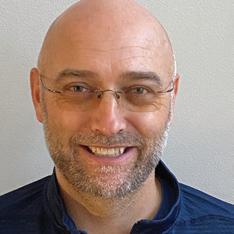
Christopher Savoie, ATP/SMS, CRTS ®, works for the University of Michigan Health – Wheelchair Seating Service in Ann Arbor, Michigan. Savoie is an at-large board member for iNRRTS and has been an iNRRTS Registrant since 1997.
Written by: ROSA WALSTON LATIMER
This year marks almost five decades that Rick Hayden has lived his “life on wheels” after a motorcycle accident in 1976 caused a T-8 spinal cord injury. “I turn 69 this year, and I’ve been wheeling around this earth and doing all this crazy stuff for 48 years,” he said. “I remember quite clearly, during rehab in Massachusetts following my accident, that I could have my college education paid for. I thought that would be great. But I was also told there were only two areas I could consider: bench work electronics and accounting. I had no interest in either, but I realized once I was enrolled, I could begin to take courses in subjects that did interest me. My first degree was in physical education. I was the first person in a wheelchair to go through that program at Springfield College in Springfield, Massachusetts. While doing my student teaching, I realized just to survive I would have to coach and teach three sports and also work a summer job. So, I went back to school and got a degree in business, and in 1987 I moved to California and began working in this industry.”
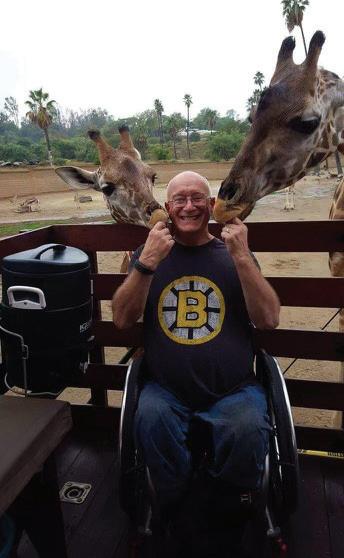
Hayden began his 32-year career with an equipment manufacturer in the health care industry and then transitioned to marketing and sales. After becoming a rehab specialist, he worked for the Department of Veteran Affairs, eventually transferring to the VA in Long Beach, California, one of the largest spinal cord injury VA facilities in the United States.
“I was acting assistant chief and had to travel quite a long distance to work while avoiding rush hour traffic. My days often began at 3:30 a.m., and I didn’t get home until 6:30 or 7:00 p.m.,” Hayden said. “I persevered for a year, but Karen (his wife) and I had a young child, and I realized how much time I was missing with my family.”

During the remainder of his career, Hayden worked for a wheelchair manufacturer as a consultant, helping small to mid-size companies launch new products, and he was an independent contractor working with equipment dealers for 10 years.
In 2015, a friend with the United Spinal Association asked Hayden to help start an affiliate chapter in San Diego County. The association has over 50 affiliates in the United States.
“I had never worked with a nonprofit and had no idea what I was getting into,” Hayden said. “Raising money is not in my skill set, but I agreed to give it a try.”
He first worked for the Southern California Chapter of the National Spinal Cord Injury Association. “The name was too long and didn’t effectively communicate our focus,” he said. “In 2018, we changed the name to Spinal Network. The organization assists wheelchair users who live in San Diego County, which has a general population of over three million.
“I’m getting the hang of this nonprofit world. We’ve received three grants in the last year and a half. That funding allows us to offer more programs and provide more resources to our members. But we have to do it all again next year to secure future funding.”
One program that is especially successful is the group’s assistive technology loan closet. “Technically, we do 60- to 90-day loans of equipment, but if it is helping

someone, and we are in the process of getting funding, we leave the equipment in place as long as needed. If we explore funding and are unsuccessful, then the equipment would be an indefinite loan.”
Hayden worked as executive director of the Spinal Network on a volunteer basis until 2023, when he began to receive compensation. “Fortunately, my wife has been teaching for a long time, and I have her insurance. She is very supportive and understands that I am trying to give back after being so blessed all of the years after I was injured,” Hayden said.
Spinal Network and the community it serves are fortunate to have someone with the enthusiasm, dedication and experience that Hayden brings to the job. “I’ve been advocating going back to peaceful protests in Boston for Section 504 – the Rehab Act, and then later for the ADA,” he said. “Although many people have helped me through the years, I didn’t always have someone to guide me so I could have my own needs met. I have a strong enough personality that when I realized I had a need that wasn’t being met, I found out where I could get help. I’m aware that may not be an easy path for others.”
Hayden believes self-advocacy is an essential endeavor for those in the disability community.
“As difficult as it can be to get individuals to advocate for something they are passionate about, instilling the idea of self-advocacy is even harder,” Hayden said. “Certainly, there is a need for advocating with a group of people for a greater cause. However, I believe before you consider that, take a look at your own needs and whether they are being met.”
Hayden nudges individuals into this practice of self-advocacy by narrowing a conversation about general advocacy to a person’s needs. “We encourage them to think through the process: What need do I have that is not being met? What possible resources are available to meet the need? Is it the Department of Rehab, Social Security, a nonprofit organization? Then, we help the individual make a plan that focuses on that particular need.” This approach of guiding the conversation invigorates an individual to take action to help themselves. “Later they can use what they have learned during the process to help others.”
The act of self-advocacy can go beyond self-care. By helping to educate others about living with a disability through actions and words, is, in a sense, self-advocating. “I always made sure whether someone wanted to include me, or not, I was included. If it was an event, I just went,” Hayden said. “At times I was excluded because it was assumed that I wouldn’t be able to negotiate the environment in a wheelchair. I always thought that was an opportunity for me to educate others. I might go to a place with five stairs at the entrance. I would hop out of my wheelchair, bump up the steps dragging my chair, hop back into the chair and go inside. That was my selfadvocacy. Of course, I was younger then. There’s no bumping up stairs now!”
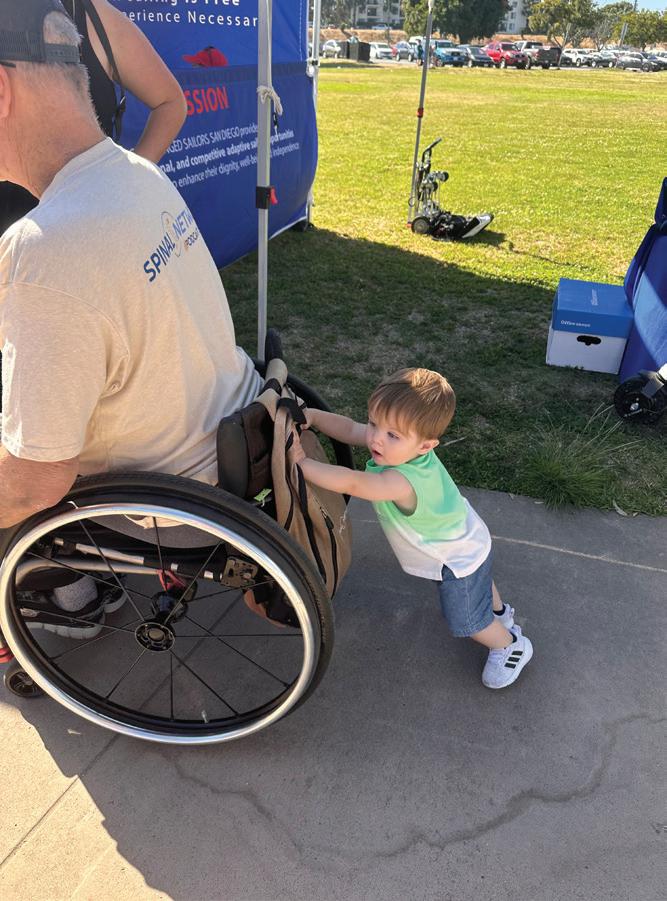
(CONTINUED FROM PAGE 15)
Another of Hayden’s guiding principles is the importance of surrounding yourself with good people. “If there is someone who is a negative influence, that person probably needs to go away. That may be a hard thing to do, especially if the person has been in your life for a long time.”
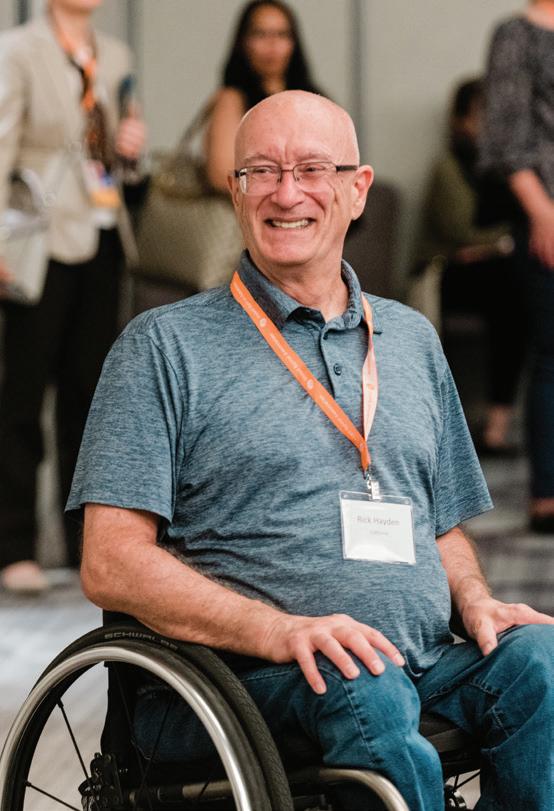
“Life is not a flat, paved road that you just roll down. There are times when you are on an uphill path and struggling. You are going to need the support of positive people to get through. If you have negative influences in your life, then you aren’t going to make it up that hill. Remember, if you are going to win this battle, you must have a good army with you.”
In addition to encouraging self-advocacy, Hayden has been involved in advocacy in a broader sense for many years. However, after beginning his work with Spinal Network, he was resistant to participating in an annual event known as “Roll on Capitol Hill,” when individuals with disabilities, their families and other supporters visit various offices in Washington, D.C. to raise awareness of the community and advocate for critical policies.
“I had zero interest in being a part of this event because I had no interest in politics,” he said. His friend at the United Spinal Association, Nick LiBassi, convinced Hayden to try it. “We had some training in Washington and traveled on the subway to Capitol Hill. I was with a small group, and I began to get nervous once we reached our destination. We met with the first Congressional staffer, and I felt pretty good about the information I presented.
“In the hallway after the meeting, I was so buzzed! The experience was very positive, and I couldn’t wait

for the next meeting! That experience changed everything, and I have now attended eight “Roll on Capitol Hill” events.
“I love my work, but the most important thing to me, above all else, is my family. Karen and I will celebrate our 37th anniversary this year. I have five incredible kids and five incredible grandkids,” Hayden said. “I have many friends who are part of the LGBTQ+ community and consider myself a solid ally. The disability community and the LGBTQ+ community sometimes face the same struggles with a lack of inclusivity and equality.
The national attention is drawn to Pride Month in June, Disability Pride in July and Spinal Cord Injury Awareness in September. Those are good opportunities to rally around those groups, but support can’t be a ‘onemonth’ thing. We need to be engaged in some way every day of every month, every year. Our fellow human beings need our support.
Bottom line, I want people to treat others kindly. I realize that is a far-reaching goal, but it will never happen if we don’t each try to do our part.”
Rick may be reached at RICK@SPINAL-NETWORK.ORG

Rick Hayden worked in the health care industry for over 30 years, primarily as a rehab specialist. After retirement, in 2015 he became the executive director of Spinal Network, a nonprofit organization that provides programs, resources and services to wheelchair users in San Diego County, California, ( https://www.spinal-network.org /) Spinal Network is an affiliate chapter of United Spinal Association. ( https://unitedspinal.org /).


Written by: CHRISTIE HAMSTRA, PT, DPT, ATP

After reading this article, you should be able to:
• Recognize, with provided examples, two ways growth can be built into a pediatric wheelchair.
• Discuss at least two components that, when properly selected, can help to decrease the overall weight of the wheelchair and seating system.
• Understand two concepts, using evidence provided, to assist with justification of lighter weight, properly fitting and optimally configured ultra lightweight manual wheelchairs for a pediatric client.
• Justify, using evidence, at least two reasons a young child should be specifically taught wheelchair skills.
Equipment selection for a pediatric client varies dramatically from an adult. Like a typically developing child that requires lots of variety in accouterments a child with a disability needs many different types of equipment as well. Over the past 20 years or so, the recommendations for proper positioning across the 24-hour period have come into greater understanding and, as such, better practice. We can no longer just look at an individual in their wheeled mobility device and determine we are done with their prescription process. Ensuring proper positioning and equipment selection for sitting, standing and lying down are all equally important in preventing further impairments, maintaining proper alignment and ensuring best participation in life. There are many incredible resources available on 24-hour positioning, including ones within DIRECTIONS magazine, so please check them out and educate yourself on what is current best practice.
Typically developing children are given all manner of opportunities for exploration and movement, but these opportunities are fewer and sometimes nonexistent for a child with a physical disability. There are many reasons for this, including, but not limited to, medical reasons, lack of education from the care team, family acceptance of disability, concern over a child getting hurt, or a singular focus on “walking.”
Determining what type of primary mobility device will work for a child is reliant on an entire team of professionals, caregivers and most importantly the child themselves. It can be very frustrating to have to select one piece of equipment to do the task of many activities, but unfortunately this is still the case in many areas of the world. ON-Time Mobility, which means at the appropriate age of development, has provided recent evidence for both a stander and gait trainer as interventions for nonambulant children with cerebral palsy (CP). (Paleg et al., 2024) We can use this research to support a request for standers and gait trainers as part of the 24-hour activity and positioning schedule along with a power or manual wheeled mobility device.
While ON-time mobility is very much an evidence-based approach, there are reasons why some children and families are unable to accept power mobility, and therefore may still select a manual wheelchair for primary mobility. The increased size and weight of the power mobility device can cause difficulties with transportation and home access, as well as some families seeing it as a last alternative. Rodby-Bousquet et al., 2016
CONTINUED ON PAGE 20

iNRRTS is pleased to offer another CEU article. This article is approved by iNRRTS, as an accredited provider, for .1 CEU. After reading the article, please visit http://bit.ly/CEUARTICLE to order the article. Upon passing the exam, you will be sent a CEU certificate.
CLINICAL PERSPECTIVE (CONTINUED FROM PAGE 19)
The role of a manual wheelchair in a child’s mobility journey is just one part and can be a tool to utilize along with ambulatory aids.
We know there will continue to be a need for manual wheelchairs for kids. Along with the changes we expect in manual wheelchair technology, our methods of prescribing them should be evolving as well. Doing what we’ve always done is no longer acceptable in this space. Part of an evidence-based practice model (Satterfield et al., 2009) includes “clinical expertise.” This is where I want to share some observations, I have made over my last six years focusing mainly on manual mobility. While this experience has been primarily adult focused, I believe we must use some of these same clinical practice guidelines and, through a similar lens, look at how we prescribe manual wheelchairs for kids. Knowing what I know now, I would have done many things differently over my 14 years as a pediatric seating therapist.
The focus of this targeted discussion is for children who will selfpropel a manual wheelchair, and to do it as independently as possible. Marginal propellers, or emerging propellers, can use some of these same principles, but they will look very different for a child who should be able to independently propel.
As with an adult ultra lightweight wheelchair prescription, attention to detail to each component and configuration of the wheelchair is essential. With kids, it is very easy to overthink and over prescribe components that it becomes almost impossible for the child to selfpropel. As we dive into this and provide recommendations for best practice, we should first look at what some of the evidence in manual wheelchairs in the pediatric space tells us. At first glance it can be discouraging. For example, there are studies that look at children and adolescents with CP and state that most of them are unable to propel a manual wheelchair (Rodby-Bousquet et al., 2016). Because of these diagnosis specific studies, and what has been done historically in manual mobility, many of these kids do not get a chance to even try and self-propel. As previously stated, many of these same children do not have access to power mobility, but we should not just throw up our hands and say, “Oh well.” I believe we should dig deeper to uncover an individual child’s functional skills and potential to help identify and push for better mobility solutions.
When prescribing “generic children’s chairs,” though “generic” is not defined, I believe it can be stated that when prescribing children’s chairs, more care and attention is paid to what is convenient for the caregiver than what is beneficial for the child (Sawatzky and Denison, 2006). While I don’t believe any child’s chair is generic, I believe this statement is very true when it comes to prescribing pediatric wheelchairs. We add stroller handles for ease of pushing when kids become fatigued and set them up higher off the ground. But what if we could set up the wheelchair better so that fatigue is not as common of an occurrence?
Typically developing kids quite often have energy in abundance, so why do our kiddos in manual wheelchairs require so much assistance? We hear often, “I’m tired, please push me,” or someone may call a child “lazy” because they ask to be pushed. This can lead to learned helplessness and limited participation, which can lead to low self-esteem and more dependence on caregivers. Manual wheelchairs shouldn’t steal away all our kid’s energy, but often this happens. We next discuss how this could be, and potential solutions to lead to improved energy throughout the entire day.
What are some of the major concerns in pediatric manual mobility? There are many answers, but one that cannot be overlooked is growth. Kids grow, and at certain points during childhood, especially puberty, they grow rapidly. The entire care team of physicians, funders, clinicians and caregivers are asking, “Will this device grow with the child?” This is a constant struggle as there is a large distinction between the need to build in growth and keeping the wheelchair at an acceptable size or weight for maximizing function for the child.
There are ways to get additional seat width without truly growing a frame by changing wheel spacing and
potentially offsetting side guard brackets. However, for most wheelchairs with pediatric applications sold and manufactured within North America, there are two options for growth: built-in growth and a growth program. Both allow the wheelchair to grow before purchasing an entirely new wheelchair, which is a requirement by almost all funding programs to ensure the product can last for a determined length of time (anywhere from three to five years). Let’s look at some advantages and disadvantages of both.
Built-in growth often allows the wheelchair to be grown in both seat width and depth without the need to procure many new parts from a manufacturer, if any. Hardware and tubing are usually already on the wheelchair, and adjustments can be made to “grow” the chair. There are definite advantages to this, as the wheelchair can be sized to “fit” the child’s hip width at delivery but usually have up to 2 inches of additional growth available as needed. Cost can be another advantage, as the parts are included in the original price of the wheelchair. The major disadvantage to this, while very convenient for all parties involved, is that built-in growth makes it very challenging to keep the overall wheelchair as light as possible. Due to the built-in growth, pediatric wheelchairs can often be the same weight, if not heavier, than an adult manual wheelchair (Sawatzky and Denison, 2006).
Growth programs usually allow for the wheelchair to be grown once during the period of funding. They most likely have some growth built into the wheelchair, usually seat depth, and lower leg length, but not seat width. The major advantage of this type of program is overall weight. Because growth and hardware aren’t built-in at the beginning, the overall weight of the system can be several pounds lighter than built-in growth models.

However, the disadvantage is there is no width growth until parts are procured, which often requires another seating therapist evaluation and request for funding, adding time onto the process. This means having a good understanding of a child’s growth pattern is essential for selection of a growth program over having growth built into the system. With a growth program, making the initial seat too wide to anticipate growth would disregard any biomechanical benefits of making the wheelchair as light as possible.
Regardless of which type of growth is selected for the pediatric wheelchair, proper measurements are crucial. Building in too much width growth can have a detrimental effect on skill acquisition and efficiency with propulsion as seen with adults. What makes this even more difficult with kids is the length of time it can take to procure funding. Months can pass between an initial evaluation of the equipment, and the approval to purchase. It is best practice to re-measure a child if it has been more than three months from the time of evaluation to the time of purchase. Especially because it is very hard to predict when a child is going to hit a rapid growth spurt. We know that most children with disabilities follow their own type of growth curve, some with an accelerated pace, and others with a much gentler and sometimes minimal pace. This is an additional step usually for the supplier and possibly the clinician, but it can ensure the right size of wheelchair is ordered.
With all the previous discussion about the growth needs for a child, and the challenges of getting a pediatric wheelchair as light as possible, we can expand on the concept of “overall weight” and look at some wheelchair to body weight ratios in case examples. Understanding how much they weigh individually can help to determine your component selection priorities. Sawatzky and Denison point out that wheelchair weight to bodyweight ratios is .44 for a child and .21 for an adult. That is, typically a wheelchair is almost 50% of a child’s body weight vs. about 20% for an adult. When looking at these numbers it makes sense as to why children often ask to be pushed!
CONTINUED ON PAGE 22
CLINICAL PERSPECTIVE
(CONTINUED FROM PAGE 21)
A few examples of children who have had well over that 44% of body weight on their wheelchair are as follows:
Wheelchair weight: 31.8 lbs.
Child Weight: 38 lbs.
Percentage of Body Weight: 83.6%
Wheelchair Weight: 36 lbs.
Child Weight: 48 lbs.
Percentage of Body Weight: 75%
Both children’s wheelchairs were built to be as light as possible, however the children themselves are still very light and therefore their wheelchair to bodyweight ratios are very high. Even taking into consideration every component as we discussed, kids still have large barriers to propulsion when it comes to weight. There may then need to be other ways to cut down the wheelchair weight.
Quite often focus is placed on seating, positioning and what is easiest for the caregiver over what allows independence for the child (Sawatzky and Denison, 2006). Some observations I have made over my career are in the interest of “low maintenance” and “safety;” some of the heaviest and least efficient seating and components are placed on children’s wheelchairs. With every possible seating component – headrest, chest strap, armrest, etc. placed on the wheelchair, along with enough room to grow into it, these wheelchairs can easily weigh 100% or more of a child’s body weight. With them being so heavy, it is no wonder they are forced to ask for assistance.
Common heavy components placed on pediatric wheelchairs include solid seat pans (to attach additional seating components) hip guides, abductors, lateral supports and other positioning elements that may be desirable for midline, static positioning. These devices are often placed on manual wheelchairs to narrow the seating system to fit a child, and to be removed as the child grows. If there is that much seating required, it is quite possible that the child will not be able to selfpropel because the wheelchair will be too wide and heavy. However, with our independent propellers in mind, we must make function and
independence the goal. We must eliminate some of the positioning components to allow for functional movement. This returns us to best practices in growth. Fit the wheelchair to the child today, (maybe 1 inch wider at most) and have a plan to grow it in the future. Do not build it for them to grow into because that steals from efficiency and independence. It cannot be stated enough that prescribing wheelchairs for children that need to grow makes it hard to get them as light as an adult manual wheelchair.
Selecting only the necessary components and not everything they could possibly need is best practice. We should also not be prescribing everything that is little to no maintenance before giving the children or caregivers a choice of lighter, more efficient components. (RESNA Application of Ultra lightweight ... 2022) Historically every child got a mag wheel with pneumatic tires with airless inserts because we assumed families wouldn’t want to or couldn’t maintain a spoke wheel and an air tire. There may be many families that still choose mag wheels as now they can have color and they may not want to worry about maintenance, but presenting the options, educating and allowing the family to choose what they feel capable of maintaining is best practice. Knowing the research from the last five to 10 years about rolling resistance and efficiency, it is essential that all the information is shared so the best decisions can be made.
The evidence is very clear that a lighter rear wheel, a spoke wheel and an air tire will cause the least amount of friction/rolling resistance and make it easier to propel. (Ott et al., 2022) Ensuring proper inflation of the air tires can also decrease the physical strain in children by up to 15% (Sawatzky and Denison, 2006). Educating and empowering the caregiver/child to check and maintain proper air pressure is also very important. Most parents can do maintenance on a bike tire, a wheelchair is similar. By selecting the lighter rear wheel and ensuring proper tire inflation, these two factors alone can make it easier for a child to propel. The answer to, “They get their fingers stuck in the wheels,” is a spoke guard,
but most of the kids who are truly self-propelling will learn very quickly to not put their fingers in between the spokes. It is also important to provide education on when to change or upgrade components that were a temporary solution, so as to continue with skill acquisition and not fall into the pattern of repeated wheelchair prescription.
Hand rim selection can be an important consideration with kids. They have smaller hands and quite often begin propelling on the tire itself. Selecting a hand rim that can be mounted flush with the rear wheel and then moved out as they begin to acquire skills is an option. An alternative solution is a high friction hand rim as not as much hand strength is required for propulsion. Gloves may be required depending on what type of terrain/ slopes are traversed as a high friction hand rim can cause a burn when at high speed.
Other components that are often placed on manual wheelchairs for kids are armrests and trays. If a child is going to self-propel, especially a small child, quite often armrests get in the way and are therefore removed. Trays are often provided for use at school or for eating but will block self-propulsion and add a significant amount of weight. These can both be provided as it is near impossible to mount a tray onto a manual wheelchair without armrests, but child/caregiver should be educated that these can and should be removed for independence with propulsion.
The debate about a posterior head support enters at this point. Often it is a requirement for school bus transportation to have a head support attached to the manual wheelchair. This can add obvious weight to the chair. Most children who self-propel do not need
CONTINUED ON PAGE 24

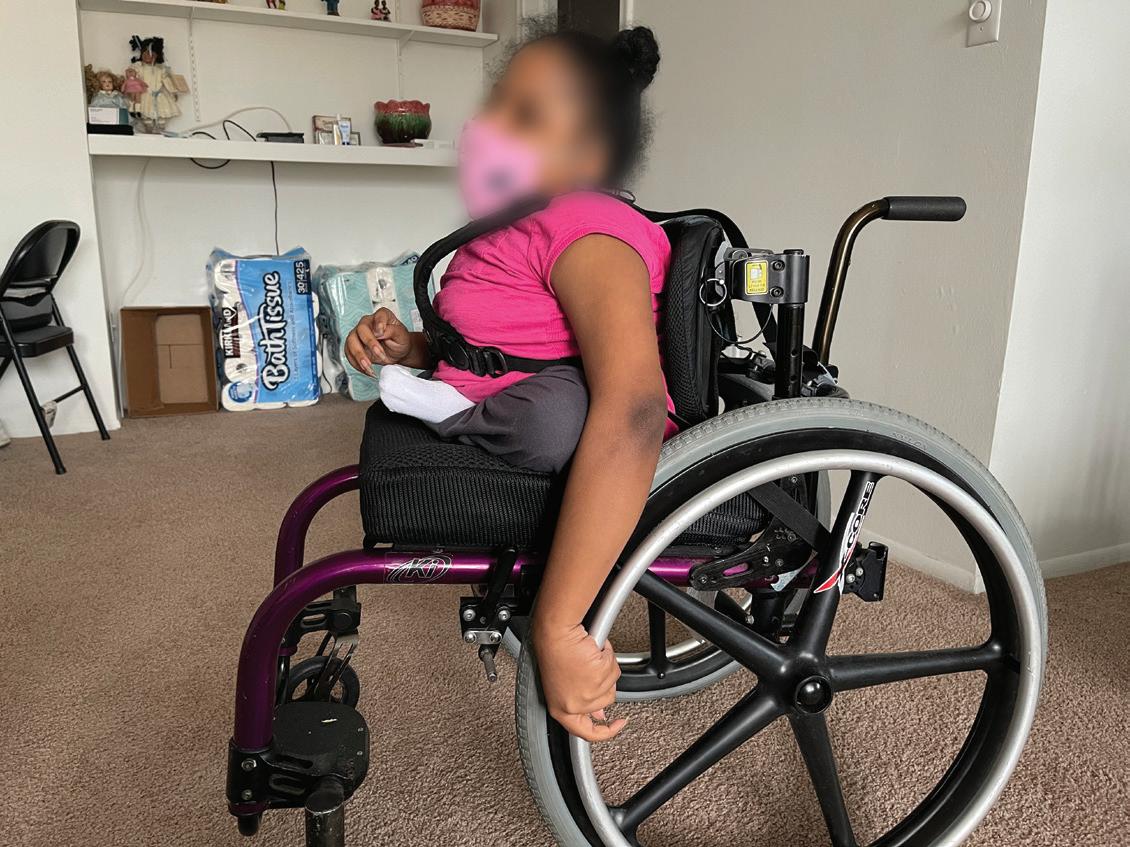
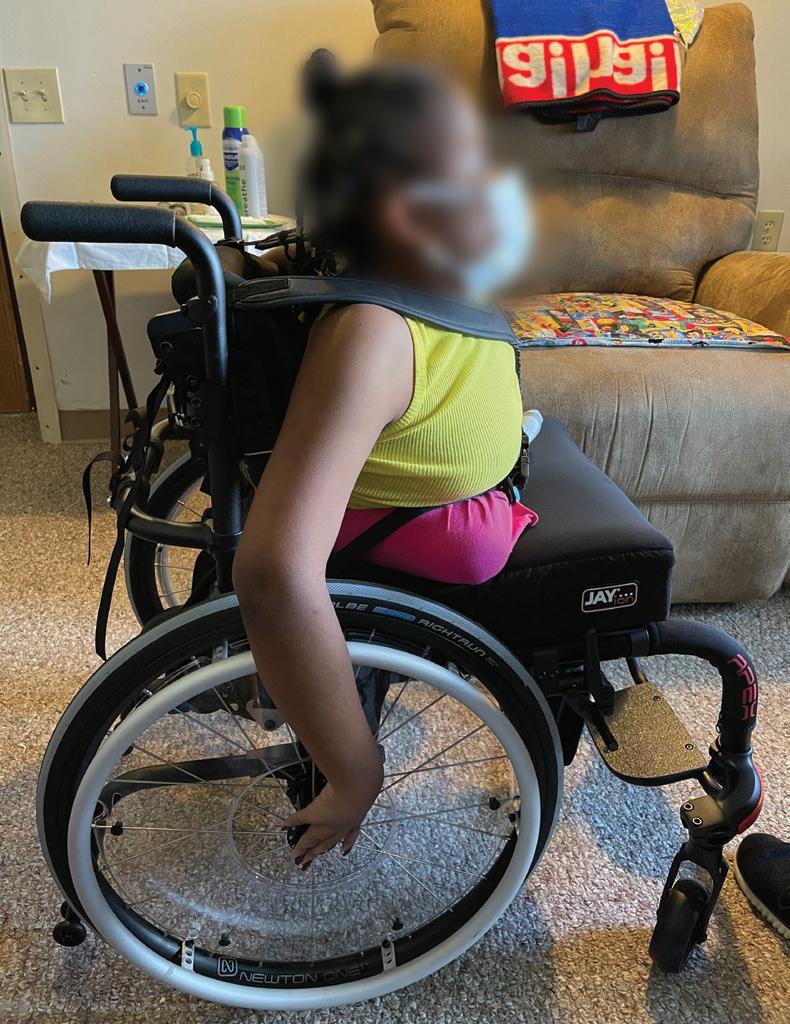
CLINICAL PERSPECTIVE
(CONTINUED FROM PAGE 19)
head support throughout the day, so again educating that headrests can and should be removed to reduce overall weight for most of a child’s daytime activities is imperative. Typically developing children are given the responsibility of keeping track of their items at school, wheelchair parts are just additional items to keep track of. We shouldn’t assume they aren’t able to manage this and educate all parties on the importance of the weight savings and managing their own equipment.
The most important part in component selection is that whatever is placed on the child’s wheelchair is necessary, and not there “just in case.” If our mindset can be changed to critically evaluate each child’s unique presentation instead of the easier road of re-creating the same wheelchair prescription for each child, better outcomes can be achieved.
Material selection can come into consideration when there is a greater need for lightweight solutions due to the bodyweight to wheelchair weight ratios previously discussed. We know aluminum is the standard material used to manufacture manual wheelchair frames for adults or children. But other materials that are stronger and lighter, like carbon fiber and titanium, could be a valuable addition to your prescription. If the entire frame weight can be lowered by a few pounds, then it might be a way to keep the overall weight down when all the necessary components are added. Because a child might only weigh 40-50 lbs., a “few” pounds has significant impact on weight savings. A more durable material may be an additional benefit over the lifetime of the wheelchair because kids tend to be more active.
Whenever a discussion of upgraded material, or material other than standard arises, the debate over who will fund it inevitably follows. There are certain geographical areas where getting a material like carbon
fiber or titanium for a child is currently not possible through most traditional funding sources. Thankfully there are loopholes and some alternative funding sources that will pay for them. However, as with any change in technology in the medical field, there needs to be a new precedent set. There are clear medical justifications for titanium and carbon fiber that, when looked at, could be applied to pediatrics. The weight difference can make significant clinical differences with upper extremity weakness, limited range of motion, fatigue, tone, spasticity and more.
Here is an example of a child in the U.S. who received funding for a carbon fiber wheelchair based on clear documentation of why his medical condition and function justified the need. The therapist had the child propel in their current 16” wide wheelchair with a lot of seating, including lateral supports, headrest, hip guides and a shoulder high back support. Because of the child’s significant cardiac and respiratory history, (previously having been on a ventilator), he became winded when propelling his current wheelchair. The therapist used a pulse oximeter to track the child’s O2 saturation before and after propelling his current wheelchair, and then at another session with a carbon fiber ultra lightweight wheelchair. See Tables 1 and 2 with details of trials.
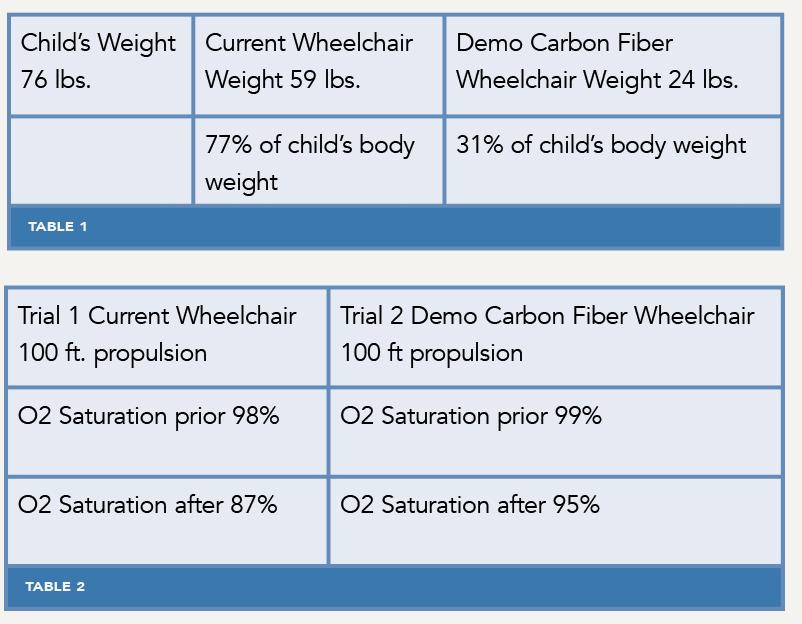
Using this objective data from the trials, along with evidence of how people really use their manual wheelchairs, starting, stopping and turns, (Sonenblum et al., 2012) the therapist justified and procured funding for the carbon fiber ultra lightweight rigid manual wheelchair.
There are many areas like Canada and Australia where, with proper justification, materials other than standard, including titanium and carbon fiber, can be justified and covered by some funding sources.
At times, when funding sources are limited, there can be the opportunity for the client/family to pay the difference between what a private insurance will fund and the cost of the upgraded material. This depends heavily on the payer, their contracts with the specific provider and other options, but it should be considered if it is something the clinical team finds value in.
If clinicians/suppliers are not willing to ask for something that we know can be justified to improve the function and quality of life of a child, how will funding sources ever recognize the need for it?
With mobility base, growth, weight, seating, components and material all considered, ensuring the proper configuration for the individual child is where the magic happens. With adults, significant time is spent discussing weight distribution, center of gravity and proper measurements. This is another instance where these practices should carry over to the pediatric population. Where we are challenged, is getting the weight distribution and center of gravity set up for function and independence and not just safety with shorter seat depths. This may require being more creative with smaller rear wheel diameters to get the center of gravity more forward.
Backpacks and all the extra things that are often placed on the back of a child’s wheelchair also make the optimal center of gravity difficult to maintain. If time is spent on decreasing the overall weight of the wheelchair and setting it up for performance, but a 20 lb. backpack is put onto the wheelchair, most of the advantage is lost. Education about reducing what is carried if possible and centering the load with under seat pouches and bags are good alternatives.
The wheelchair prescription process should not end at delivery but continue into training for skill acquisition. It cannot be assumed that every kid will just figure out how to best maneuver themselves in a manual wheelchair within whatever environment they find themselves in. Just as typically developing kids learn skills through trial and error, children using a manual wheelchair should have some of the same experiences. However, trial and error must occur alongside training sessions for proper body mechanics and efficiency, as these are not inherent human skills. Best et al., 2023 states “simply providing a manual wheelchair does not guarantee independent or safe use.” Acquiring wheelchair skills can improve participation in physical activity, which will most likely improve health and quality of life.
CLINICAL PERSPECTIVE
(CONTINUED FROM PAGE 26)
When looking for evidence regarding wheelchair skills training in the pediatric population, the results are discouraging. In one study looking at wheelchair skills training programs and effectiveness, a survey of 68 rehab centers showed that less than two hours was spent in wheelchair skills training —18% of those centers provided no training at all, and less than 30% of those who did training used any type of evidencebased training program, and the focus was on very basic skills (Ouellet et al., 2022).
Rushton et al., brings forward that “without wheelchair skills training, there are important costs to the wheelchair user (e.g., decreased independence, chronic and acute injuries and society/caregiver burden).” Researchers are noting the lack of pediatric wheelchair skills training evidence, making it no wonder children are pushed more and thereby are overall less confident in wheelchair skills. “Wheelchair confidence involves six areas, namely negotiating the physical environment, activities performed in a wheelchair, knowledge and problem solving, advocacy, managing social situations and managing emotions” (Pituch et al., 2021). It is important to understand that while wheelchair skills can be observed, wheelchair confidence cannot, and it is a newer idea that deserves a deeper look.
Skills training should begin with basic skills such as wheeling forward and turning, advance into ramps, wheelies and transfers in and out of the wheelchair. As important as ambulation training is, it is every bit as important that a child learns to transfer in and out of the wheelchair for greater independence in all daily activities, and that independence can lead to increased confidence and in turn greater quality of life. By providing wheelchair skills training, not only can kids achieve the physical skills required for increased independence but also gain confidence that will transfer to other areas of their lives.
There are evidence-based wheelchair skills pediatric programs. They are a great starting point, which can then evolve onto more advanced skills, including wheelies, as the child progresses and gains confidence. Just as a typically developing child will learn and gain confidence in new mobility skills, a child in a manual wheelchair should be given the same opportunities. The wheelchair Skills Training Program is available free online and is a great resource for all levels of clinicians. https:// wheelchairskillsprogram.ca/en/pediatric/
As stated at the beginning of the article, kids need many pieces of equipment to access all the environments they need to interact with for true participation. Manual wheelchairs aren’t made for all types of terrain and can thereby be a hindrance to full participation for a child. An introduction to power add-ons at earlier stages, with proper training, can be a good compromise and potentially allow access to more environments. As with any other component, the process of selecting a power add-on needs to be thorough and options trialed to ensure the correct device is selected for the child.
It has been discussed in literature that many, if not most, children in manual wheelchairs require assistance and are pushed a large part of the time. Instead of just accepting this and allowing the children to become more dependent, looking at the appropriateness of the wheelchairs could begin to direct us into better prescriptions.
Individualized evaluations and identifying the unique goals of each child is the beginning.
• Proper wheelchair base selection, including the material.
• Measure for the fit of the wheelchair today and plan either with built-in growth or a growth program, based on functional abilities and anticipated changes.
• Select the appropriate and lightest components, including seating, don’t put everything on the wheelchair “just in case.”
• Educate the families on why these decisions are being made to help with understanding the importance of efficiency, participation and maintaining health over time.
• Look for power add-ons when appropriate. Teach wheelchair skills early, often and not just the basics.
The justification of that selection should be based on all the elements discussed above as well as weight savings, efficiency and independent mobility.
Encourage families to become involved in advocacy at both a state/provincial and national level to push for better policies and funding for equipment. Ask manufacturers to provide better and lighter products, so that kids who do utilize manual wheelchairs aren’t pushing around 90% of their body weight. Rethinking what has always been done and pushing funding sources with advocacy is incredibly important to move the needle in the pediatric manual wheelchair prescription process.
REFERENCES
BEST, K. L., RUSHTON, P. W., SHERIKO, J., ARBOUR-NICITOPOULOS, K. P., DIB, T., KIRBY, R. L., LAMONTAGNE, M. E., MOORE, S. A., OUELLET, B., & ROUTHIER, F. (2023). EFFECTIVENESS OF WHEELCHAIR SKILLS TRAINING FOR IMPROVING MANUAL WHEELCHAIR MOBILITY IN CHILDREN AND ADOLESCENTS: PROTOCOL FOR A MULTICENTER RANDOMIZED WAITLISTCONTROLLED TRIAL. BMC PEDIATRICS, 23(1). HTTPS://DOI.ORG/10.1186/ S12887-023-04303-8
EKIZ, T., ÖZBUDAK DEMIR, S., SÜMER, H. G., & ÖZGIRGIN, N. (2017). WHEELCHAIR APPROPRIATENESS IN CHILDREN WITH CEREBRAL PALSY: A SINGLE CENTER EXPERIENCE. JOURNAL OF BACK AND MUSCULOSKELETAL REHABILITATION, 30(4), 825–828. HTTPS://DOI.ORG/10.3233/BMR-150522
FURAMASU, J. (2018) CONSIDERATIONS WHEN WORKING WITH THE PEDIATRIC POPULATION. IN M. LANGE & J. MINKEL (EDS.) SEATING AND WHEELED MOBILITY: A CLINICAL RESOURCE GUIDE (PP. 281-296) SLACK INCORPORATED.
OTT, J., WILSON-JENE, H., KOONTZ, A., & PEARLMAN, J. (2020). EVALUATION OF ROLLING RESISTANCE IN MANUAL WHEELCHAIR WHEELS AND CASTERS USING DRUM-BASED TESTING. DISABILITY AND REHABILITATION: ASSISTIVE TECHNOLOGY, 17(6), 719–730. HTTPS://DOI.OR G/10.1080/17483107.2020.1815088
OUELLET, B., RUSHTON, P. W., CÔTÉ, A.-A., FORTIN-HAINES, L., LAFLEUR, E., PARÉ, I., BARWICK, M., KIRBY, R. L., ROBERT, M. T., ROUTHIER, F., DIB, T., BURROLA-MENDEZ, Y., & BEST, K. L. (2022). EVALUATION OF PEDIATRIC-SPECIFIC RESOURCES TO SUPPORT UTILIZATION OF THE WHEELCHAIR SKILLS TRAINING PROGRAM BY THE USERS OF THE RESOURCES: A DESCRIPTIVE QUALITATIVE STUDY. BMC PEDIATRICS, 22(1). HTTPS://DOI.ORG/10.1186/S12887-022-03539-0
PALEG, G. S., WILLIAMS, S. A., & LIVINGSTONE, R. W. (2024). SUPPORTED STANDING AND SUPPORTED STEPPING DEVICES FOR CHILDREN WITH NON-AMBULANT CEREBRAL PALSY: AN INTERDEPENDENCE AND F-WORDS FOCUS. INTERNATIONAL JOURNAL OF ENVIRONMENTAL RESEARCH AND PUBLIC HEALTH, 21(6), 669. HTTPS://DOI.ORG/10.3390/IJERPH21060669
PITUCH, E., RUSHTON, P. W., CULLEY, K., HOUDE, M., LAHOUD, A., LETTRE, J., & ROUTHIER, F. (2021). EXPLORATION OF PEDIATRIC MANUAL WHEELCHAIR CONFIDENCE AMONG CHILDREN, PARENTS, AND OCCUPATIONAL THERAPISTS: A QUALITATIVE STUDY. DISABILITY AND REHABILITATION: ASSISTIVE TECHNOLOGY, 18(7), 1229–1236. HTTPS://DOI.ORG/10.1080/17483
107.2021.2001059
RESNA POSITION ON THE APPLICATION OF ULTRALIGHT MANUAL WHEELCHAIRS (2022); REHABILITATION ENGINEERING AND ASSISTIVE TECHNOLOGY SOCIETY OF NORTH AMERICA RESNA.ORG
RODBY-BOUSQUET, E., PALEG, G., CASEY, J., WIZERT, A., & LIVINGSTONE, R. (2016). PHYSICAL RISK FACTORS INFLUENCING WHEELED MOBILITY IN CHILDREN WITH CEREBRAL PALSY: A CROSS-SECTIONAL STUDY. BMC PEDIATRICS, 16(1). HTTPS://DOI.ORG/10.1186/S12887-0160707-6
SAWATZKY, B. J., & DENISON, I. (2006). WHEELING EFFICIENCY: THE EFFECTS OF VARYING TYRE PRESSURE WITH CHILDREN AND ADOLESCENTS. PEDIATRIC REHABILITATION, 9(2), 122–126. HTTPS://DOI.ORG/10.1080/13638490500126707
SONENBLUM, S. E., SPRIGLE, S., & LOPEZ, R. A. (2012). MANUAL WHEELCHAIR USE: BOUTS OF MOBILITY IN EVERYDAY LIFE. REHABILITATION RESEARCH AND PRACTICE, 2012, 1–7. HTTPS:// DOI.ORG/10.1155/2012/753165
CONTACT THE AUTHOR
Christie may be reached at C.HAMSTRA@MOTIONCOMPOSITES.COM

Christie Hamstra is a physical therapist and Assistive Technology Professional who first worked in the wheelchair industry as a seating therapist, and then as a supplier, and is now full time as a clinical education specialist for Motion Composites. Hamstra brings her passion and expertise in wheelchair prescriptions to every client interaction from pediatrics to geriatrics, as well as mentorship and encouragement to other clinicians. Hamstra has presented at many regional and international conferences on three different continents including ISS, CSMC, ESS, OSS and ATSA.
Written by: MICHELLE L. LANGE, OTR/L, ATP/SMS
iNRRTS would like to thank Seating Dynamics for sponsoring this article.
We are wired to move. Most of us are born moving and continue to do so our entire life. Our bodies are designed to move – it is easier to move than to stay still! When movement is prevented or restricted, we experience negative physiological effects. Research has demonstrated that prolonged sitting has many negative health consequences, including increased stress on the tissues and systems of the body, pain, fatigue and decreased productivity. In the United States, the average adult sits for 9.5 hours a day (Matthews, et al., 2021)!
Many wheelchair users sit for the majority of their waking hours. Just as movement is important and healthy for everyone, movement is also important for people using wheelchairs. Movement is sometimes provided in a power wheelchair through power seating functions such as tilt, recline, elevating leg rests, seat elevation and standers. Tilt and seat elevation do not actually cause movement of the client’s body parts in relation to one another, as the seated angles do not change. While some of these features are available on manual wheelchairs, the client is typically dependent on others to activate this movement.
Depending on the individual and the required seating system, the client may not move very much within that seated position. Most wheelchair seating systems are static. If the client moves, they will move out of alignment with the seating surfaces. Some clients can move in relation to their seating system and independently return to an aligned position; however, many clients will require repositioning by a caregiver.
Dynamic seating can provide movement in response to client forces. Depending on the force exerted, a dynamic back, dynamic
footrests and/or dynamic head support hardware will move a corresponding distance. The design of these components is critical to ensure that the client can move and maintain postural alignment within the seating system. This is achieved by placing the pivot points of the dynamic seating components as close as possible to the body’s natural pivot points, particularly at the hips and knees.
Dynamic seating is used in three primary clinical scenarios. First, it is used to diffuse force that could otherwise lead to client injury, equipment breakage, loss of position within the seating system, decreased sitting tolerance, increased agitation, decreased function, and further increases in extension and energy consumption. Secondly, it is used to allow movement to provide sensory input, increase alertness and decrease agitation. Thirdly, dynamic seating can improve postural control, stability and function.
Meet Jozie, a 3 1 ⁄ 2 -year-old little girl with the diagnoses of epilepsy and West syndrome. West syndrome is now often referred to as infantile spasms syndrome and is characterized by spasms, developmental regression and hypsarrhythmia (a highly irregular pattern of brain electrical activity). She underwent a corpus callosotomy in April 2021 (at age 10 months) to better control her seizure activity by dividing the corpus callosum, the bundle of nerves connecting the two cerebral hemispheres. Jozie reportedly now has on average one seizure a day (tonic clonic, followed by spasms), typically while
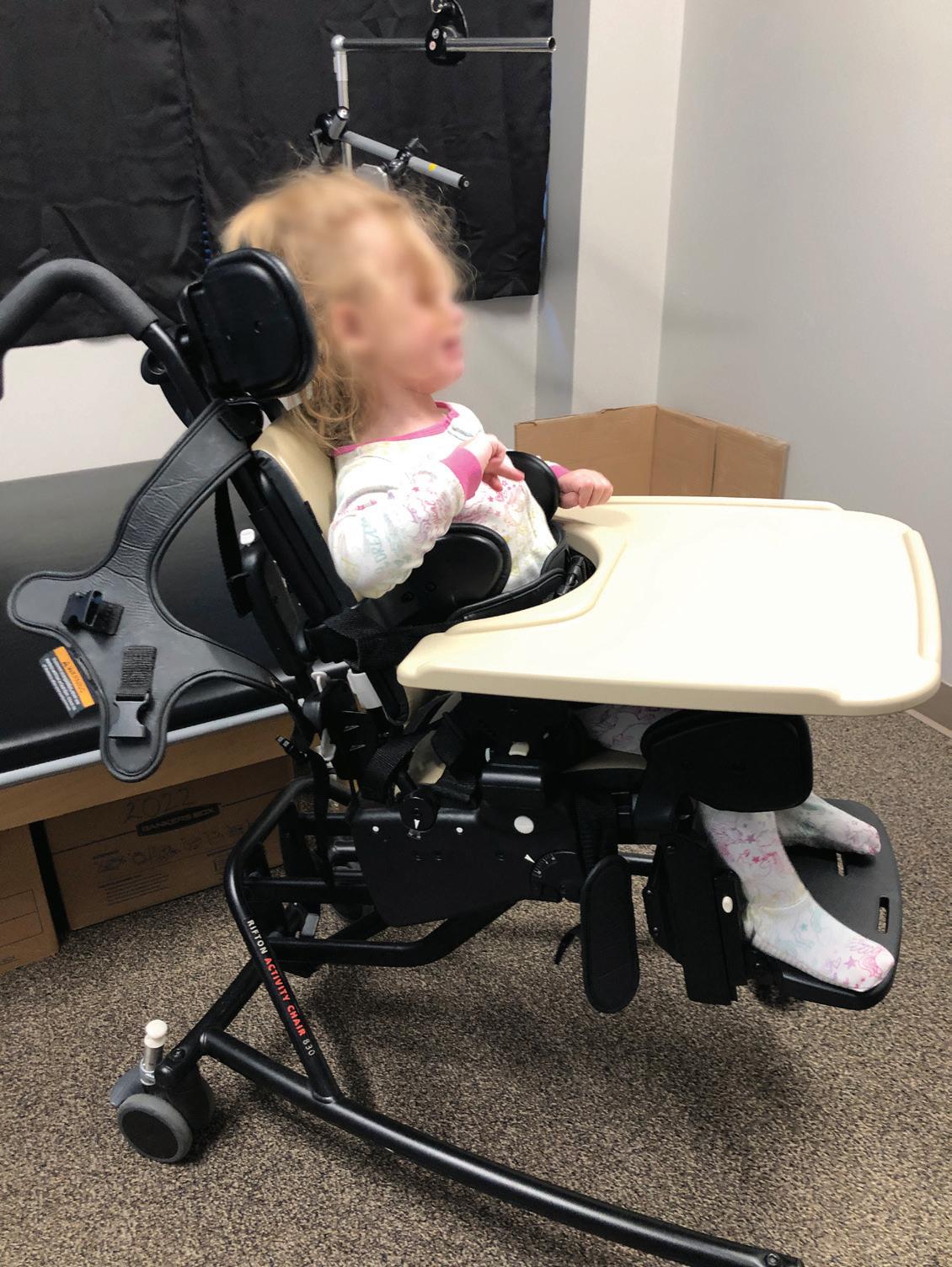
asleep. She has cerebral visual impairment, and her hearing is normal. Jozie can sit independently for 20 to 30 minutes, though can fall over during this time. She can roll from her stomach to her back, is non-ambulatory and non-verbal. She receives physical, occupational and speech language therapies at home. Jozie also receives augmentative communication therapy at an outpatient clinic.
When I first met Jozie, she was 2 ½ years old. She used a standard baby jogger style stroller and highchair. She also had a Leckey Squiggles stander (now under Sunrise Medical), Firefly Splashy bath seat, Rifton Pacer gait trainer and AFOs. Jozie spent time on the floor, in a Lazy Boy chair and in her highchair, which she was outgrowing. The standard stroller did not provide adequate postural support and so she was unable to sit upright in this base.
Jozie had full range of motion with slight hamstring tightness. She was able to sit on the edge of the mat table with minimal assistance, though would lean into me if I moved away. Jozie sought out movement and other sensory input; particularly she liked to rock from her hips. This rocking appears to calm her, as well as increase alertness. She was showing us that she wanted, and needed, to move.
REHAB CASE STUDY
(CONTINUED FROM PAGE 29)
Jozie needed a mobility base to transport her from location to location and provide adequate postural support. We discussed adaptive strollers vs. manual wheelchairs and decided on a manual wheelchair to provide maximum growth, support an appropriate seating system and support a mounting system for a future speech generating device. I thought she would also benefit from a dynamic back, as she tended to rock and seek out movement.
Jozie was placed in our clinic’s Rifton Activity Chair with a dynamic back (Figure 1 shows Jozie in the activity chair moving the dynamic back). This activity chair provided more support than her standard stroller and simulated many of the postural supports we were considering. This adaptive seat also allowed us to see how she responded to a dynamic back. She quickly found that the back moved if she extended at her hips, and she began to rock. She enjoyed this movement, which appeared to increase her sitting tolerance as well as calm her.
We recommended a tilt-in-space manual wheelchair to allow a position of rest if she fatigues due to her young age and postseizure fatigue. This base needed to be stable so that it would not tip due to her rocking movements. We recommend a Ki Mobility ARC pediatric manual wheelchair with rotational tilt to maintain stability. This base was also compatible with a Seating Dynamics dynamic back (the Dynamic Rocker Back interface). We recommended an off-the-shelf cushion (Comfort Company Embrace with anti-thrust modification) with a pelvic positioning belt (mounted at 60 degrees to limit posterior pelvic tilt), and an off-the-shelf back (Comfort Company Acta Embrace) with swingaway lateral trunk supports and a chest strap. The footplates were padded as she often goes barefoot or wears only socks. A simple contoured head support (Stealth Products Adjustable Comfort Plus) was added to provide posterior and lateral support during tilt. Finally, a tray was ordered to provide a work surface.
Other dynamic components were not recommended. Jozie did not require dynamic footrests as she does not tend to extend her legs. Dynamic head support hardware was not indicated as she does not extend at the neck. Her movement was confined to a rocking motion at the hips, which was best addressed with a dynamic back.
We also recommended a Rifton activity chair with mobile base, tilt, hi-low base and dynamic back. This provided an alternative seat that could be used at various heights for different activities in the home.
Finally, the current bath seat was not working well for Jozie as she had to sit up straight and the postural supports got in the way of hygiene and her movements. Instead, we recommended a Leckey Advance bath chair, which could support her a in a reclined position. This was much safer if Jozie had a seizure during bathing, as well.
Jozie fit well in her new manual wheelchair, as adequate postural support was provided (see Figures 2 and 3). This support improved her ability to access her speech generating device via scanning using switches by her hands.
At the delivery, the dynamic back was configured with elastomers of medium resistance, which is the default. Although the dynamic back moved slightly in response to her hip extension, the resistance was too high (see Video 1). Yellow (soft) elastomers were placed in the dynamic back, which then responded more readily to her rocking movements (see Video 2).
Only eight short months after delivery, Jozie was already growing out of her seating system. She had undergone considerable growth in this time period. The current cushion was at maximum growth, and she was tending toward a posterior tilt in sitting. A new cushion that incorporated future growth and provided more anti-thrust build-up in the contour was recommended. Used in combination with the current dynamic back, this would promote a more neutral pelvis.

When a client extends their hips, the body can push off the back of the seating system into posterior pelvic tilt. The dynamic back moves in response to these forces, diffusing much of the force and guiding the client to return to a neutral upright position. As the pivot point is at the same level as the natural pivot point of the hips, movement is allowed into mild hip extension and back to upright without a loss of posture.
The off-the-shelf back was also at maximum growth, already being raised 3 inches above the surface of the cushion. If this was raised further, her posterior pelvis would be unsupported and collapse into a posterior tilt.
CONTINUED ON PAGE 32

REHAB CASE STUDY
(CONTINUED FROM PAGE 31)
A new, taller back was recommended with swing-away lateral trunk supports. A new chest strap was also recommended. The new back incorporated a bi- angular shape to promote an upright pelvis and trunk extension. The swing away lateral trunk supports were curved as Jozie tended to get her arms trapped between her body and the current flat lateral trunk supports.
Even though quite young and not weighing very much, Jozie has been rocking in her dynamic back for eight months and has worn out the current elastomers. These were replaced with new Yellow (soft) elastomers, as this level of resistance was still appropriate. As the current elastomers were worn, we noted that the back was “sagging” into a more open seat-to-back angle. Her parents noticed that it was getting more difficult to latch (lock-out) the dynamic back, as the elastomers was worn. Replacing the elastomers restored the correct seat-to-back angle, eased latching the dynamic back and made the back more responsive to Jozie’s movements.
A new cushion that incorporated future growth and provided more of an anti-thrust build-up in the contour was recommended (Comfort Company Inception with contoured anti-thrust). A new, taller back was recommended with swing-away lateral trunk supports and chest strap (Stealth Products True Forming linear back with I back, biangular back shape and curved swing-away lateral trunk supports). The worn elastomers in the dynamic back were replaced with new elastomers of the same resistance level.
Jozie has received her new seating and is positioned well. She is well aligned, stable and able to move at her hips without loss of position. The new seating system has growth built-in to accommodate her growth, we hope, for a long time.
Without dynamic seating, Jozie would certainly “fit” in her wheelchair seating system. The seating system would match her body dimensions and provide postural support where needed. However, despite appropriate seating, Jozie’s repeated hip extension would continue to push her into a posterior tilt. And a
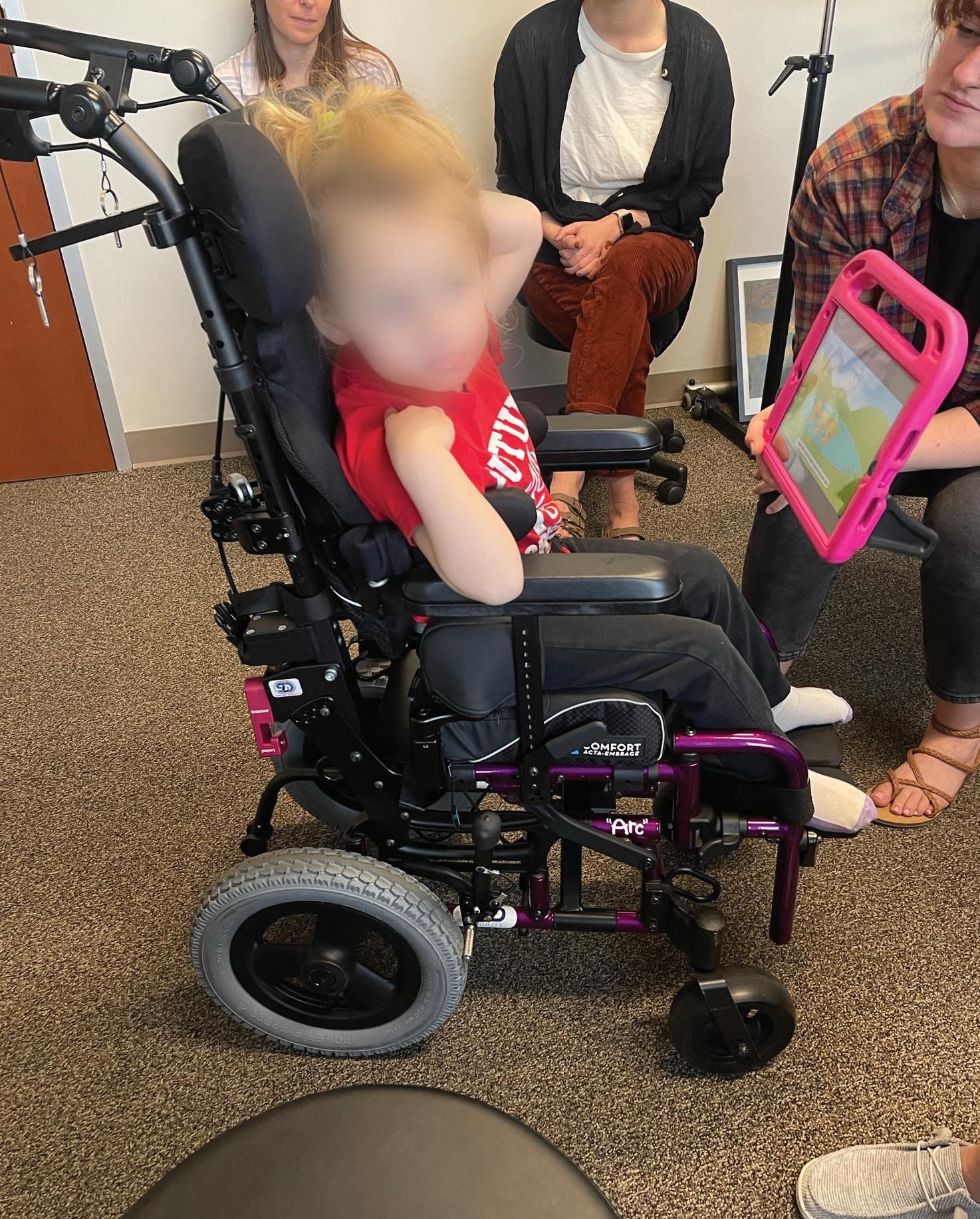
lack of movement would lead to increased agitation and decreased alertness. Providing movement as a part of the wheelchair and seating system was a critical part of the overall solution.
Movement is important and healthy for all of us. Let’s not forget that movement within the seating system is a valid wheelchair seating goal!
The Centers for Medicare and Medicaid Services approved Healthcare Common Procedure Coding System Level II code E2398 “Wheelchair accessory, dynamic positioning hardware for back” effective January 1, 2020. A Preliminary Medicare Payment Determination was made in May 2022, comparing E2398 to E1015 “Shock Absorber for Manual Wheelchair.” When CMS is trying to determine a fee schedule for a code, one of their methods is to do a cross walk, which compares that item to
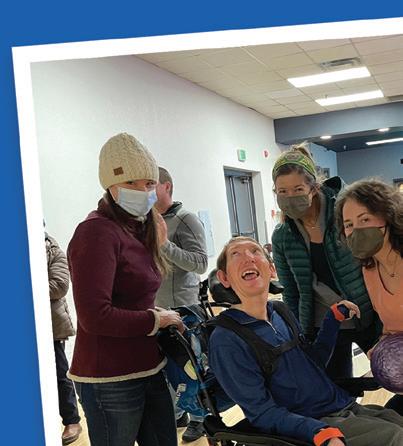
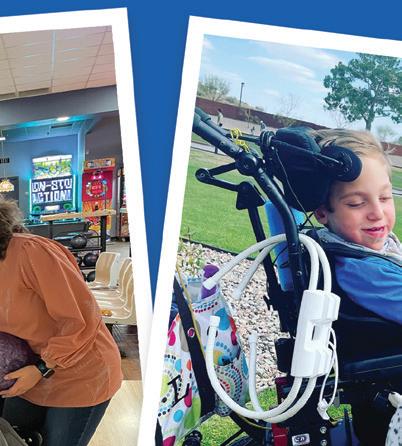

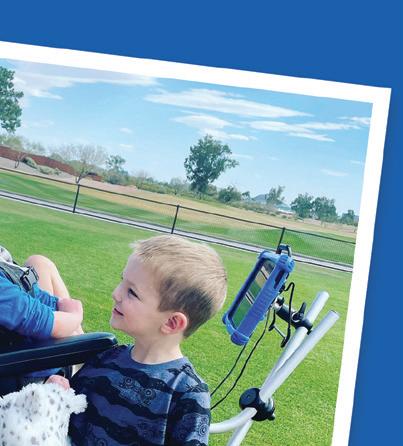






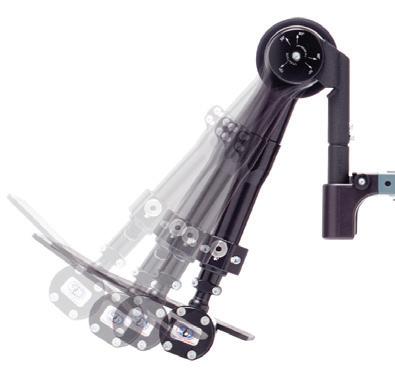
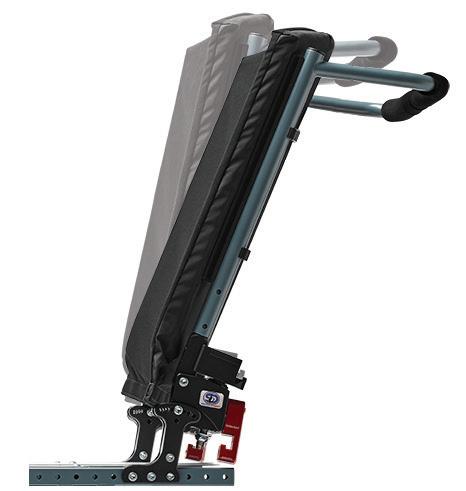
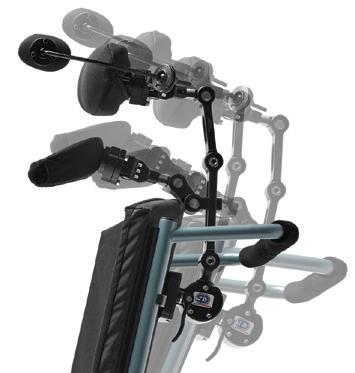
another coded item which already has a fee schedule. The payment determination for the code is then based upon the cost of the item which already has a fee schedule. The proposed reimbursement rate was between $152.55 to $183.02, far below the cost to manufacture any Dynamic Back. Despite significant industry efforts over several years, the new payment schedule went into effect April 1, 2024. Seating Dynamics is working hard to continue to provide the Dynamic Rocker Back to those who need this intervention.
REFERENCES
MATTHEWS, C. E., CARLSON, S. A., SAINT-MAURICE, P. F., PATEL, S., SALERNO, E., LOFTFIELD, E., … & BERRIGAN, D. (2021). SEDENTARY BEHAVIOR IN UNITED STATES ADULTS: FALL 2019. MEDICINE AND SCIENCE IN SPORTS AND EXERCISE, 53(12), 2512.
Michelle may be reached at MICHELLELANGE1@OUTLOOK.COM
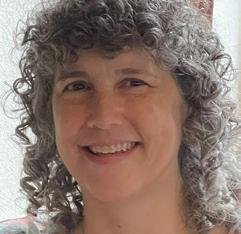
Michelle Lange is an occupational therapist with over 35 years of experience and has been in private practice, Access to Independence, for over 15 years. She is a well-respected lecturer, both nationally and internationally, and has authored numerous texts, chapters and articles. She is the co-editor of Seating and Wheeled Mobility: A clinical resource guide and is a Friend of iNRRTS, RESNA Fellow and member of the Clinician Task Force. Lange is a RESNA certified Assistive Technology Professional and Seating and Mobility Specialist.
Written by: ROSA WALSTON LATIMER
“I believe it is important to surround yourself with knowledgeable professionals and dependable resources,” Kelly Cox, MSPT, said. “This is especially true early in your career, but regardless of your experience, you benefit from the positive support of others.” Cox has applied these words of guidance to her career of over 30 years as a physical therapist. She has been a pediatric physical therapist at High Hopes Developmental Center for 20 years.
High Hopes Developmental Center in Franklin, Tennessee, is distinctive as an inclusive preschool and pediatric therapy center, all in one location. The center provides physical, occupational, speech and feeding therapies to children from birth through young adulthood. It was established in 1984 by five families, each with a child with a special need not being met in local preschools.
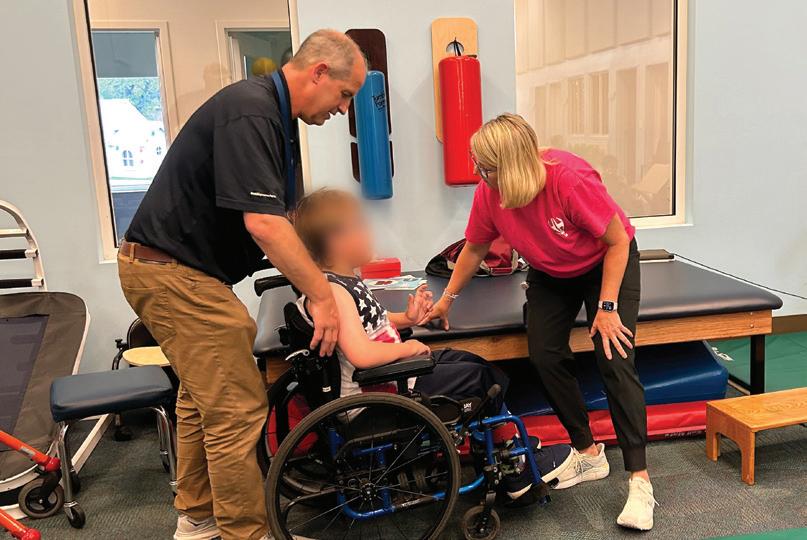

“We serve children at the school and also have children who come for outpatient therapy,” Cox said.
Initially, I planned to have a career as a veterinarian, so my undergraduate degree was in zoology. However, I worked in several clinics while attending college and ultimately decided that was not something I wanted to do. I began to investigate other medical fields and decided upon physical therapy. I was drawn to PT because I’ve always been active and interested in wellness and health.
I made a good decision! My first job was in acute care, followed by outpatient orthopedics, and then I transitioned to pediatrics. When I went to work at the Children’s Hospital of Alabama, I began working with the rhizotomy team and assisting with wheelchair clinics. I realized this was my place! I met my husband while working in Alabama. He began his fellowship in St. Louis, MO, so I transferred to St Louis Children's Hospital where I was very fortunate to work with Dr. T.S.
Park, one of the leading rhizotomy surgeons. That experience was invaluable and influenced future professional decisions and experiences.
Upon completion of my husband's fellowship, we moved once again, this time to Nashville, TN, where I worked at Vanderbilt Children's Hospital. While my husband and I worked, our children attended childcare and preschool at High Hopes. I believed in the mission of High Hopes so when a PT position became available, I joined the therapy team and have been there ever since.
I’ve always worked part time, two or three days a week which has allowed for a great work/life balance. I’m very research-oriented and focus on spasticity and tone management. We emphasize acquiring appropriate equipment for our patients, and I am fortunate that we have enough storage to keep equipment on hand for patients to try. I work one additional day per month coordinating and serving as the PT in our equipment clinic. In this clinic, I collaborate with Durable Medical Equipment (DME) vendors, like Andy Foster, OTR/L, ATP, from Numotion, to assess children's equipment needs, order, fit, and train caregivers. Patients can use these with their PT sessions before deciding on what is best for them.
Obviously, for many years, I was handwriting all of my notes, and now they are all electronic. I don’t remember being required to write letters of medical necessity for all equipment. The paperwork documentation has gotten more extensive. On the positive side, we now enjoy excellent access to research, mentors and others who can provide support and answer questions.

Families are busier now than in the past, but with the option of telemedicine, making connections is more accessible. I can see the equipment in the home. It is nice to have access to a photo or video on a phone to evaluate a patient’s use of equipment.
I love the people I work with! Everyone is committed and intelligent. Working within that supportive environment is a huge bonus for me. I also enjoy working with families and sharing the experience of fighting hard to get a power chair or other equipment and delivering it to the child. I enjoy a challenge and will not accept an insurance denial without giving it my all. We work hard to make our patient interactions fun, positive and effective.
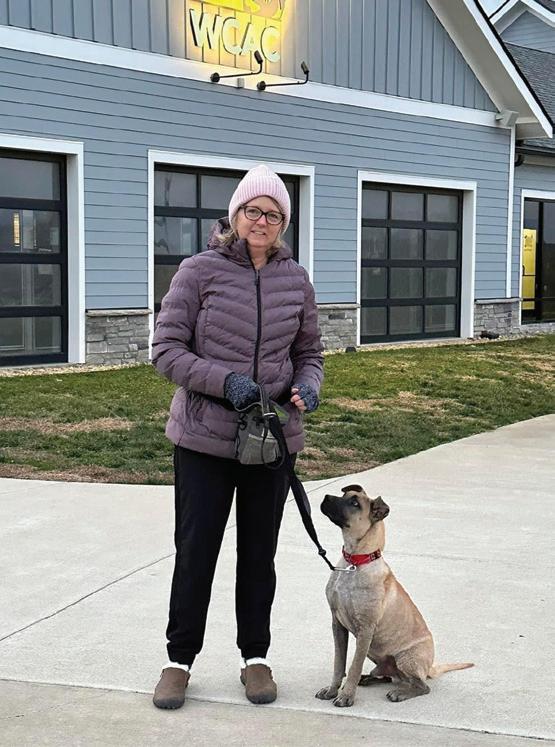
Our family is very important to me. My husband is a nephrologist in private practice. We have three children: McKenzie, 22, who is in dental school; Lauren, 20, who is currently attending Belmont University in Nashville and planning to attend dental school; and Ethan, 18, who will be a freshman at Auburn in the fall.
I enjoy reading, hiking with friends and walking my two dogs — Barkley, a Golden Retriever, and Zoey, a Cavapoo. I spend a lot of my time at the county animal shelter, where I work the “sunrise” shift that begins at 6:30 a.m. I also volunteer with the Franklin Challengers, a special needs baseball team that several of the High Hopes children participate in. Any child who has a physical or intellectual disability can play. During their season, the girls and I go to the games and serve as “buddies” to the players.
In the clinic, it is definitely nice to see all of my notes done and the proper equipment delivered to my patients. However, I think success for me is seeing the joy in my patients and families after achieving their accomplishments, big or small.
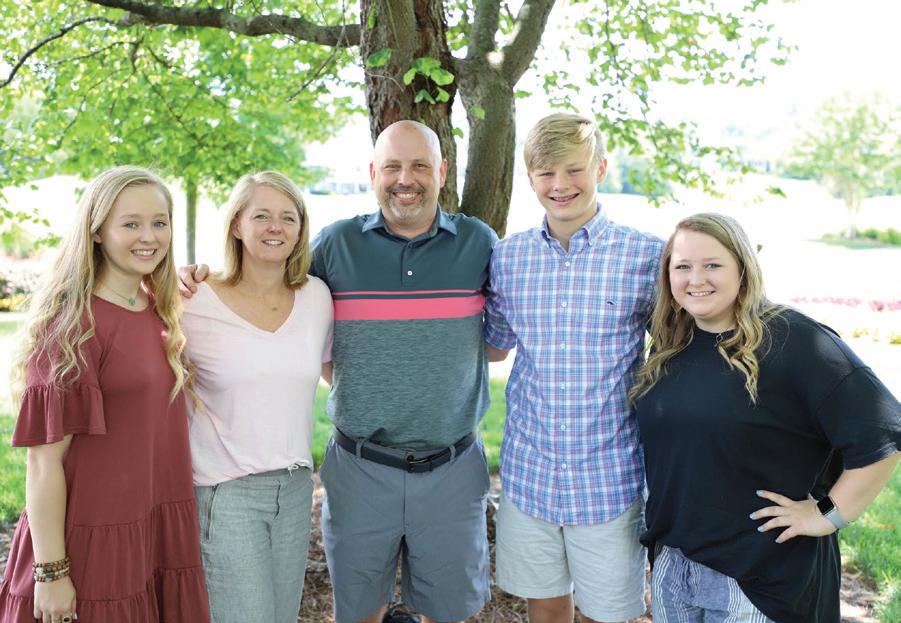
Kelly may be reached at KCOX@HIGHHOPESFORKIDS.ORG
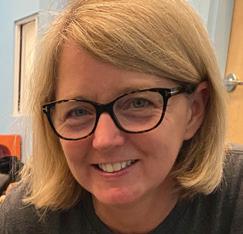
Kelly Cox, MSPT, has extensive experience in pediatric physical therapy working at Vanderbilt Children’s Hospital, St. Louis Children’s Hospital, and Children’s Hospital of Alabama. She has expertise in the areas of serial casting and therapy related to spasticity management. Cox is a pediatric physical therapist at High Hopes Developmental Center in Franklin, Tennessee, where she has been on staff for 20 years.
Written by: ANDREA MADSEN, ATP
In today’s rapidly evolving world, the ability to adapt and thrive in the face of change has become a cornerstone of success for individuals and organizations alike. The Complex Rehab Technology industry is characterized by its complexity and the specialized nature of the equipment and services it provides. Suppliers must navigate a landscape that includes diverse patient needs, rapidly advancing technologies and stringent regulatory requirements. The constant evolution of interventions, coupled with the necessity to deliver personalized solutions, demands a high level of expertise and adaptability from CRT professionals.
As our profession undergoes significant transformations driven by technological advancements, shifting market dynamics and evolving consumer expectations, one strategy has proven to be indispensable: investing in education. This investment not only equips individuals with the necessary skills and knowledge but also fosters a culture of continuous improvement and innovation.
The modern CRT professional landscape is characterized by constant change. Technological innovation is a driving force in the complex rehab technology industry. New devices and solutions are continuously being developed, offering improved functionality and enhanced outcomes for users. For suppliers, staying abreast of these advancements is essential as in such a dynamic environment, static skill sets quickly become obsolete. This is where
the concept of continuous learning comes into play. Continuing education enables CRT professionals to understand the capabilities and limitations of new technologies, ensuring they can make informed recommendations that best meet their clients’ needs. By committing to ongoing education, CRT professionals can stay ahead of the curve, ensuring their skills remain relevant and their contributions valuable.
Investing in education cultivates adaptability and resilience, two qualities that are critical in navigating change. When individuals are equipped with up-to-date knowledge and skills, they are better prepared to embrace new methodologies and technologies. This adaptability not only enhances individual performance but also contributes to organizational agility. Suppliers that prioritize employee education are better positioned to pivot in response to market shifts and technological advancements, maintaining a competitive edge.
Education is a powerful catalyst for innovation and creativity. Exposure to new ideas, diverse perspectives and emerging trends stimulates critical thinking and problem-solving abilities. By investing in education, suppliers create an environment where innovation can flourish. Employees who are encouraged to learn continuously are more likely to propose novel solutions, identify opportunities for improvement and drive progress within their teams and the broader organization.
CRT suppliers must adhere to a complex web of regulations and standards designed to protect consumers and ensure the efficacy of products. Regulatory requirements can change frequently, and failing to comply can result in legal ramifications and compromised patient care. Continuing education provides CRT professionals with up-to-date
CONTINUING EDUCATION ENABLES COMPLEX REHAB TECHNOLOGY PROFESSIONALS TO UNDERSTAND THE CAPABILITIES AND LIMITATIONS OF NEW TECHNOLOGIES, ENSURING THEY CAN MAKE INFORMED RECOMMENDATIONS THAT BEST MEET THEIR CLIENTS’ NEEDS.
knowledge on regulatory changes, ethical considerations and best practices, helping them navigate the compliance landscape effectively.
The provision of CRT involves a multidisciplinary approach that encompasses clinical assessment, technical configuration and ongoing support. Suppliers must possess a deep understanding of both the medical aspects of disability and the technical specifications of assistive devices. Continuing education bridges the gap between these domains, enhancing professionals’ ability to deliver comprehensive, effective solutions that improve the quality of life for individuals with disabilities.
Ultimately, the goal of CRT is to improve patient outcomes by enhancing mobility, independence and overall quality of life. Continuing education equips CRT suppliers with the latest knowledge and skills to achieve this goal. By staying current with advancements in technology and best practices, professionals can offer more effective, personalized solutions, leading to better patient satisfaction and improved long-term outcomes.
In an industry where trust and credibility are paramount, ongoing professional development is a powerful differentiator. CRT suppliers who commit to continuous learning demonstrate their dedication to excellence and their commitment to providing the highest quality of care. This commitment fosters trust among clients, healthcare providers and other stakeholders, enhancing the supplier’s reputation and competitive standing in the market.
A commitment to education signifies a dedication to excellence. Suppliers that prioritize learning and development send a clear message to their employees: We value your growth and are invested in your future. This fosters a culture of mutual respect and ambition, where employees feel empowered to pursue their professional goals. Such a culture not only attracts top talent but also retains it, reducing turnover rates and associated costs.
To maximize the impact of educational investments, it is essential to tailor learning paths to individual needs and career aspirations. Personalized learning approaches consider an employee’s current skill set, desired career trajectory and preferred learning style. This customization ensures that educational efforts are both relevant and engaging, leading to more effective skill acquisition and professional development.
CONTINUED ON PAGE 38
MOMENTS WITH MADSEN
(CONTINUED FROM PAGE 37)
To effectively implement continuing education, CRT suppliers can adopt several practical strategies:
Structured Training Programs: Embrace comprehensive training programs that cover essential topics, including new technologies, regulatory updates, clinical best practices and ethical considerations.
Online Learning Platforms: Leverage on line platforms to provide flexible, accessible learning opportunities. Webinars and e-learning modules can accommodate diverse learning styles and schedules.
Industry Conferences: Encourage participation in industry conferences and seminars. These events provide valuable opportunities for networking, learning from experts and staying current with industry trends.
Certificates and Professional Designations: Pursue relevant certificates and professional designations to validate expertise and commitment to professional development. These achievements and designations can enhance credibility and open new career opportunities.
Mentorship and Peer Learning: Establish mentorship programs, promote peer learning initiatives and encourage engagement in professional communities. Experienced professionals can provide guidance and support to less experienced colleagues, fostering a collaborative learning environment.
Investing in education is not merely an expense but a strategic investment with measurable returns. Suppliers can track the impact of educational initiatives through various metrics, such as improved employee performance, increased innovation, enhanced clinical outcomes, higher consumer satisfaction and enhanced competitive positioning. By evaluating these outcomes, suppliers can refine their educational strategies to ensure they continue to deliver value.
Continuing education is not just a professional obligation for CRT suppliers — it is a critical component of delivering high-quality, effective care. In an era defined by change, investing in education is not just a prudent strategy, it is a necessity. Continuous learning empowers CRT professionals to actively engage in ongoing professional development, CRT can stay current with technological advancements, navigate regulatory complexities, enhance their clinical and technical expertise and ultimately improve patient outcomes. For suppliers, it fosters a culture of excellence, enhances agility and strengthens competitive advantage. By prioritizing education, we not only prepare ourselves for the future but also actively shape it, ensuring that we can thrive in an ever-evolving world. In an industry where change is constant, a commitment to continuous learning ensures that CRT professionals remain at the forefront of innovation, providing the best possible solutions for individuals.
iNRRTS is the international leader in establishing an educational pathway to engage new participants in the CRT professional workforce and is essential for supporting individuals with the professional proficiency necessary in today’s rapidly changing environment. By identifying professionally relevant skills, offering flexible learning, providing unparalleled access to the professions foremost subject matter experts, fortifying industry partnerships and promoting
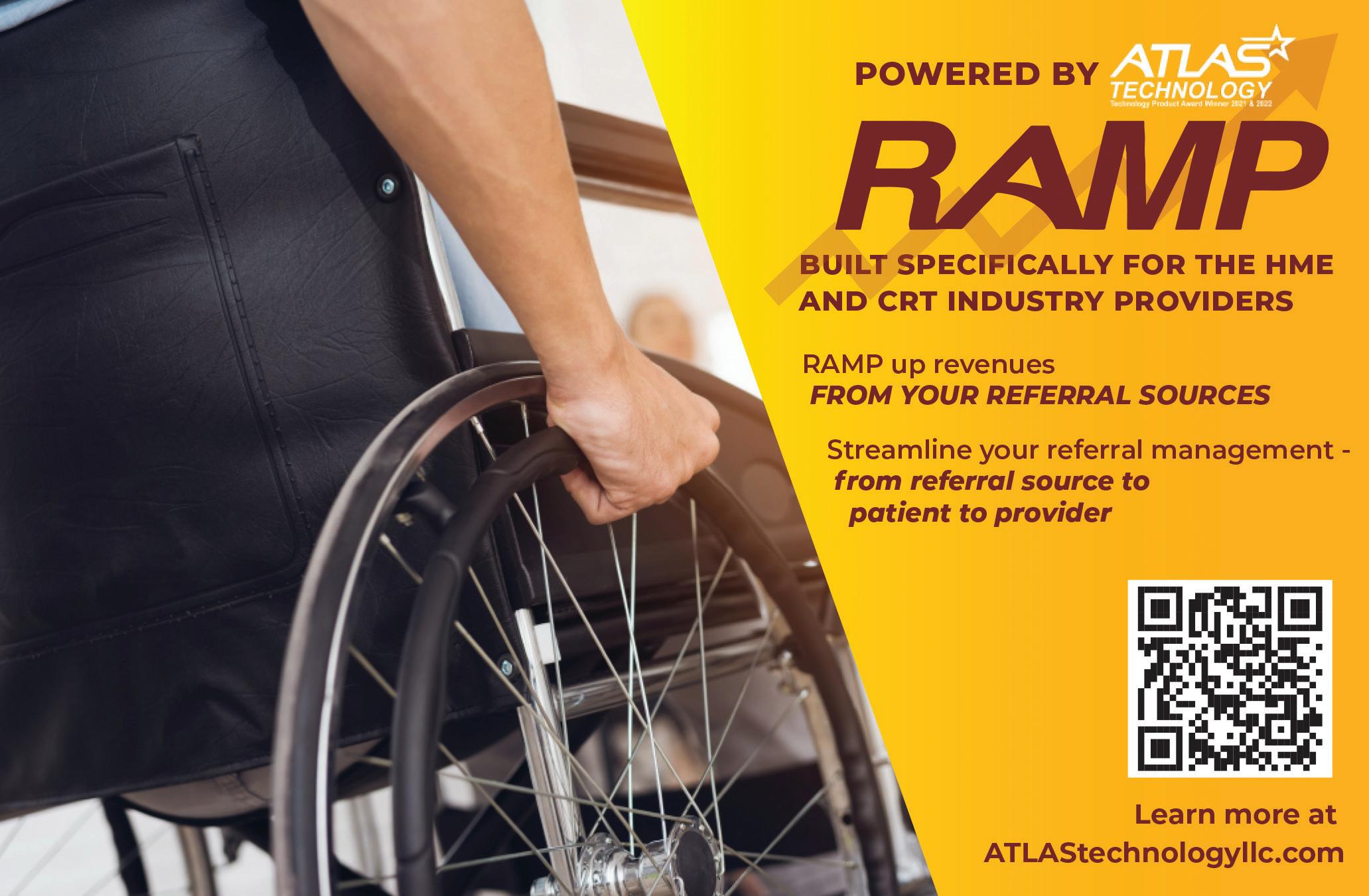
continuous learning, iNRRTS can ensure that individuals are equipped with the skills and knowledge they need to thrive.
For more information on our CRT Supplier Certificate Program, upcoming live webinars, vast on-demand webinar library and CEU articles please scan the QR code below or visit: https://nrrts.org/education/

CONTACT THE AUTHOR
Andrea may be reached at AMADSEN@NRRTS.ORG

Andrea Madsen is the executive director of iNRRTS, the International Registry of Rehabilitation Technology Suppliers. She has over 20 years’ experience providing Complex Rehabilitation Technology to adult and pediatric patients in southern Minnesota, western Wisconsin, northern Iowa and internationally through her work with the Mayo Clinic. She holds a Bachelor of Science in business management and finance, is a credentialed assistive technology professional and has been a certified Complex Rehabilitation Technology Supplier ®. She served for 10 years on the iNRRTS Board of Directors and as committee chair for the Midwest Association of Medical Equipment Services. She has lectured for the University of Minnesota Rochester, University of Wisconsin La Crosse, Mayo Clinic College of Medicine and Science and at the International Seating Symposium.
Written by: AMBER L. WARD, MS, OTR/L, BCPR, ATP/SMS, FAOTA, AND LESLIE JACKSON, OT, ATP
In 2023, Volume 6 of DIRECTIONS, the Clinician Task Force wrote about a new clinical research study being initiated by a collaborative industry group and managed by CTF Executive Director and Associate Professor at Western Michigan University Cara Masselink. The article's call to action requested suppliers' participation to provide de-identified data for review to assist with identifying potential solutions to challenges faced with denials with many insurers, particularly Medicare Advantage plans. By law, these plans must comply with traditional Medicare policies (Medicare program, 2023).
The research study has collected de-identified and complete data so far on over 30 individual clients ordering complex/Group 3 power wheelchairs from five states who all faced denials of all or part of their complex power wheelchairs; there are many more in process. Of these clients, 20 were sent to Medicare and the MA for dual submission and 25 power wheelchairs were full denials from the Medicare Advantage. The most common diagnoses represented are stroke, multiple sclerosis and spinal cord injury. Masselink, who holds a Ph.D. in interdisciplinary health sciences, notes that there have been many inquiries by interested suppliers, but fewer have followed through with submitting a monthly copy of the template with updated data.
The team has noted a few perceived barriers from suppliers and would like to address the concerns potentially preventing participation here (on following page):
We encourage the industry’s leading suppliers to join those who have already submitted data in these efforts. This will allow for higher numbers and thereby more power to present cases to the Centers for Medicare and Medicaid Services and insurances with facts and
data. Because all data is confidential and de-identified, there is no tie back to any client or group and the confidentiality of participating organizations is maintained. Participating in this effort is an opportunity to address inequities ethically and confidentially in service provision and access to Complex Rehab Technology. Having 30 clients is a great start and having hundreds of thousands of clients getting complex Power wheelchairs would be impactful and amazing.
The researchers will assist through the entire process. The suppliers keep a single running study spreadsheet, which is then turned in monthly (as a work in progress). Most template data can be copied from existing data and records that the suppliers have accessible. Suppliers can also record power wheelchairs, which only were denied by Medicare Advantage and not dual submitted if appropriate as well.
The data collection process is streamlined and user-friendly. Here's how it works (James et al., 2023):
1. Initial Contact: Interested parties will fill out a brief, six-item survey. The researchers will respond on an individual basis with a template for the supplier to record information on. Each company will maintain their own spreadsheet.
2. Submission of Requests: Suppliers will submit all power wheelchair requests with a primary funding source of a Medicare Advantage plan to both Medicare's Prior Authorization process and the plan.
3. Data Logging: Record the client and requested information along with insurance responses on the spreadsheet.
4. Repeat for Each Claim: Repeat for each request submitted to a Medicare Advantage plan.
5. Monthly Updates: Monthly, email an updated spreadsheet via secure manner to researchers (even if still in process). Keep adding data as more power wheelchairs are in process.

The collection template will request the following information over time:
• Patient ID (Supplier gives a random number), Birth Year, Diagnoses (ICD-10 codes), State
• All HCPCS codes in the request, Medicare Advantage plan name
• Medicare Advantage decision (full or partial denial or approved); Denial reason, if denied
• Medicare Decision: Report the outcome of Medicare's decision.
• Source/Company (only for internal, researcher use. This will be deleted once data collection is completed.)
With the data collected already, the study team is seeing trends/problem areas for closer scrutiny for Medicare Advantage and insurance plans. If the entire industry commits to submitting data about approvals and denials, we will make an even larger impact. This is a low-commitment, low-effort chance to have a nationwide positive impact on CRT consumers and the power wheelchair process. Thank you so much to the amazing suppliers who have already stepped up and joined the efforts. If you are a supplier who has not, especially a clinician supplier, we implore you to join us in this data collection to explore these questionable health care practices. These denials are threatening the core of our work, the well-being of clinicians, the livelihood of suppliers, and the lives of people who don’t get the technology they need.
CONTINUED ON PAGE 42
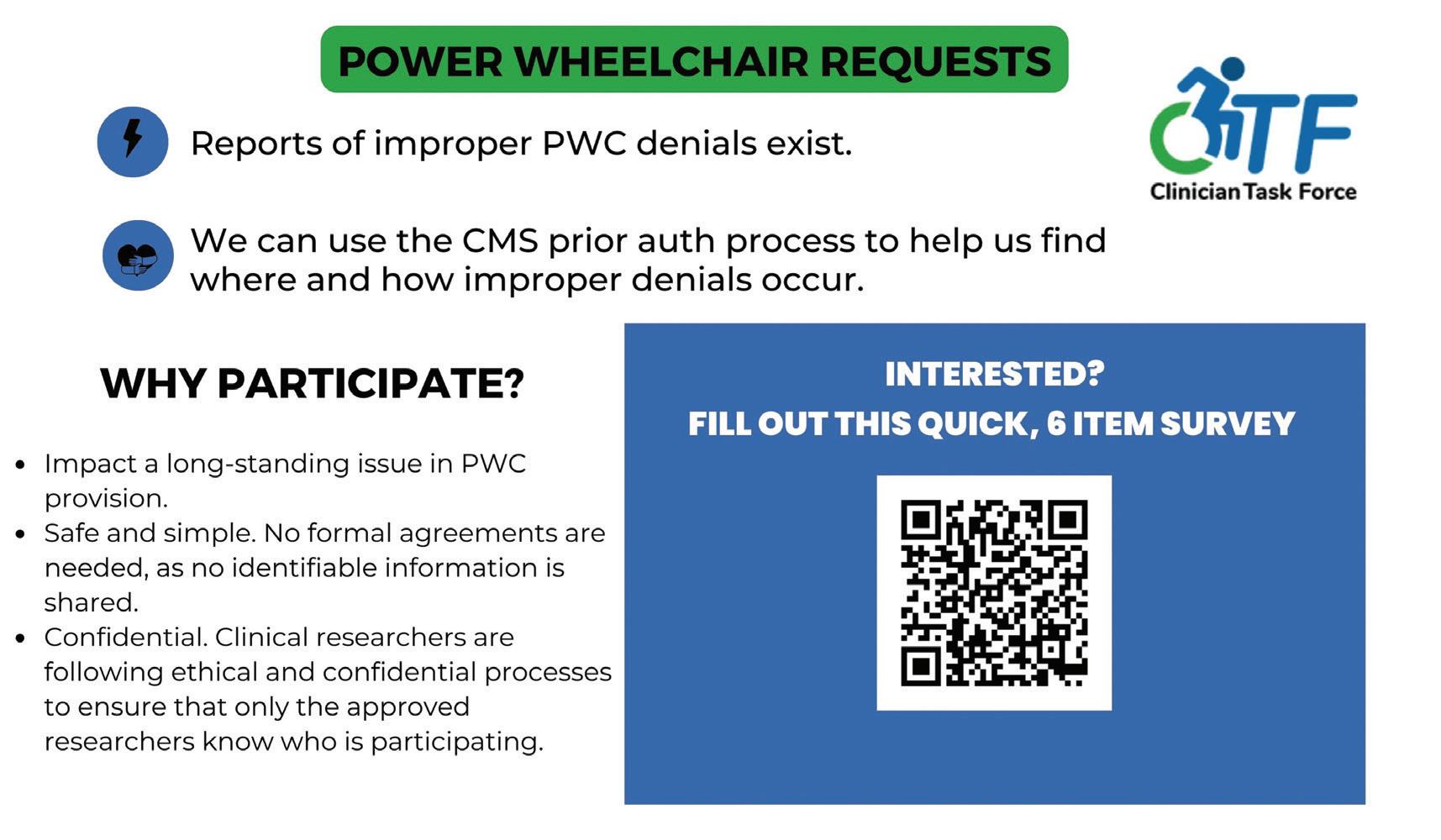
CLINICIAN TASK FORCE
(CONTINUED FROM PAGE 41)
In summary, this article highlights how the researchers are actively collecting de-identified data and ensuring confidential processes to protect participating suppliers.
The researchers appreciate the efforts of suppliers who have participated and clinicians and other stakeholders encouraging support for the project. However, additional data and suppliers are needed to support a robust study. The authors outlined proposed solutions to address perceived barriers to participation. For those who have not yet done so, we invite you to participate by completing the brief, six-item survey accessible through the QR code and staff will reach out with further instructions. The study’s findings could impact the questionable healthcare practices and problematic denials affecting the industry and the quality of life and safety of CRT clients and their families. With your participation, we can bring about meaningful change.
REFERENCE:
JAMES, T., KITTLESON, T., & WARD, A. (2023). CTF JOINS ADVOCACY ACTIONS TO IMPACT DENIALS – A CALL TO ACTION FOR SUPPLIERS. DIRECTIONS, 6., 24-25. HTTPS://ISSUU.COM/NRRTS/DOCS/DIRECTIONS_2023V6_ISSUU
MEDICARE PROGRAM: CONTRACT YEAR 2024 POLICY AND TECHNICAL CHANGES TO THE MEDICARE ADVANTAGE PROGRAM, MEDICARE PRESCRIPTION DRUG BENEFIT PROGRAM, MEDICARE COST PLAN PROGRAM, AND PROGRAMS OF ALL-INCLUSIVE CARE FOR THE ELDERLY, 81 F.R. 22121 (APRIL 12, 2023) (TO BE CODIFIED AT 42 CFR PARTS 417, 422, 423, 455, & 460).
Amber may be reached at AMBER.WARD@ATRIUMHEALTH.ORG
Leslie may be reached at OTRJACKSON@YAHOO.COM
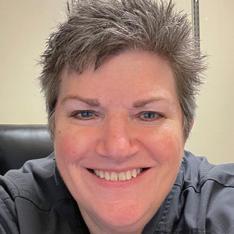
Amber Ward has been a treating occupational therapist for 30-plus years. She has treated a wide variety of patients, of all ages and functional levels. She currently is an adjunct professor at the Occupational Therapy Assistant and Master of Occupational Therapy programs at Cabarrus College of Health Sciences in addition to working in the clinic. She received the RESNA Assistive Technology Professional certification in 2004, the Seating and Wheeled Mobility certification in 2014, and became board certified in physical rehabilitation in 2010 through the American Occupational Therapy Association. She runs the seating clinic at Neurology Specialty Care, Atrium Health in Charlotte, North Carolina

Leslie Jackson has served as an occupational therapist for over 25 years in various settings, including outpatient, acute care, home health, acute rehab and a doctoral-level academic program. She currently leads the outpatient Seating and Mobility Clinic for Marion Health and serves as an occupational therapist for the Veteran Affairs’ Caregiver Support Program. Jackson earned her Assistive Technology Professional certification from RESNA in 2008 and is certified in ergonomics and LSVT BIG, a treatment protocol for individuals living with Parkinson’s Disease. She volunteers as an executive board member for the Services for the Visually and Hearing Impaired, a nonprofit organization providing assistive technology and education to its clients. Jackson is honored to contribute through the Clinician Task Force’s advocacy and educational initiatives.
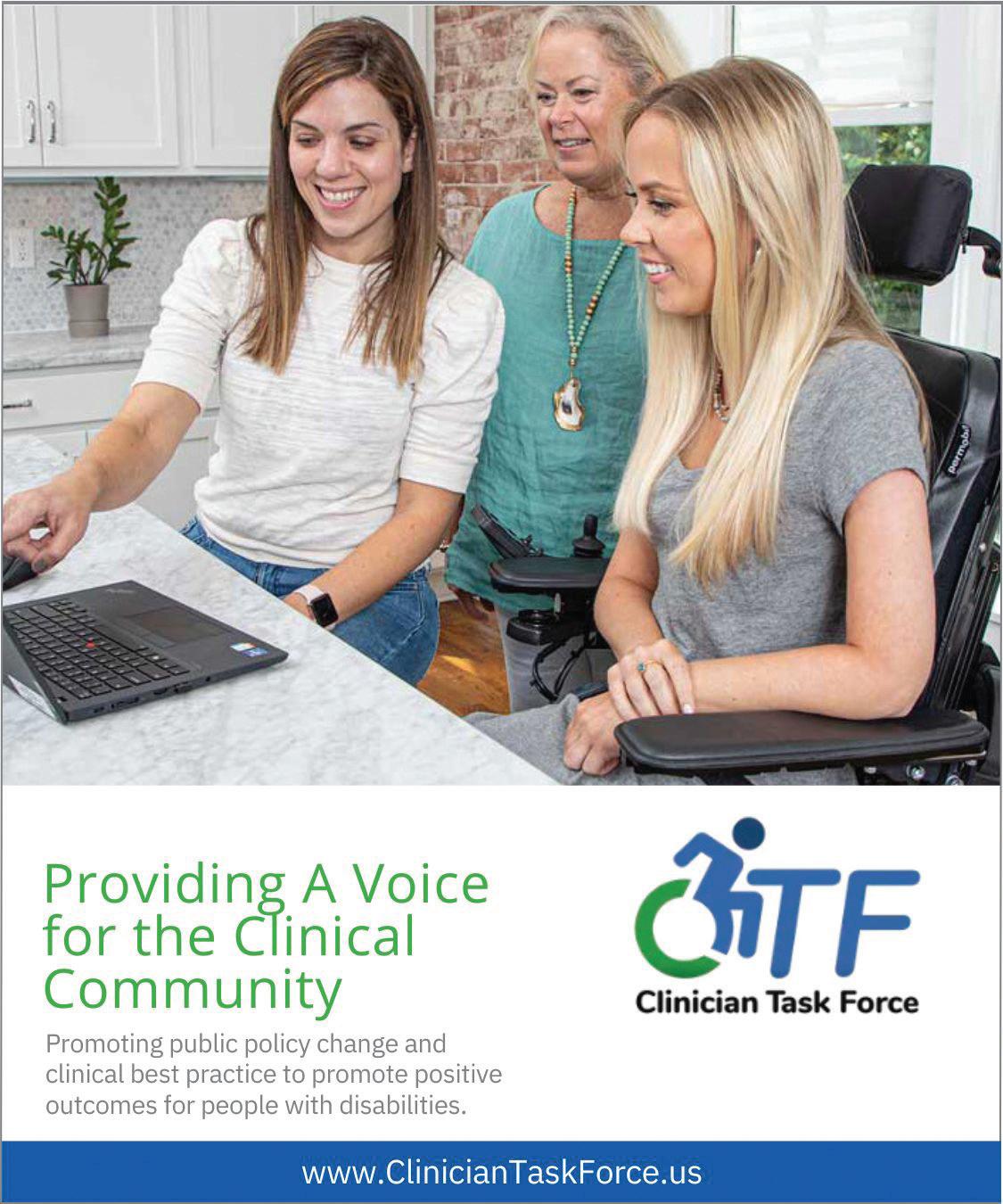
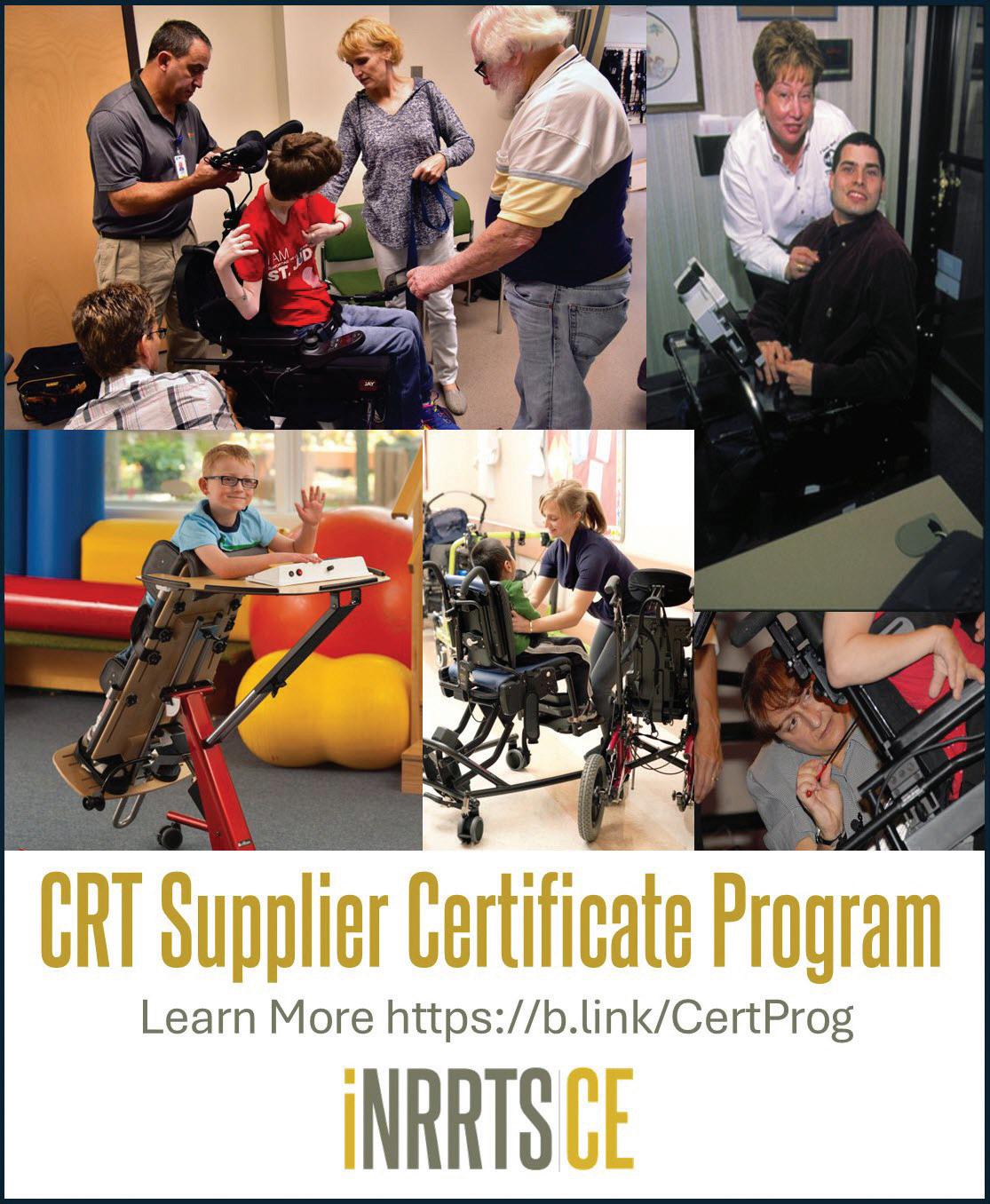
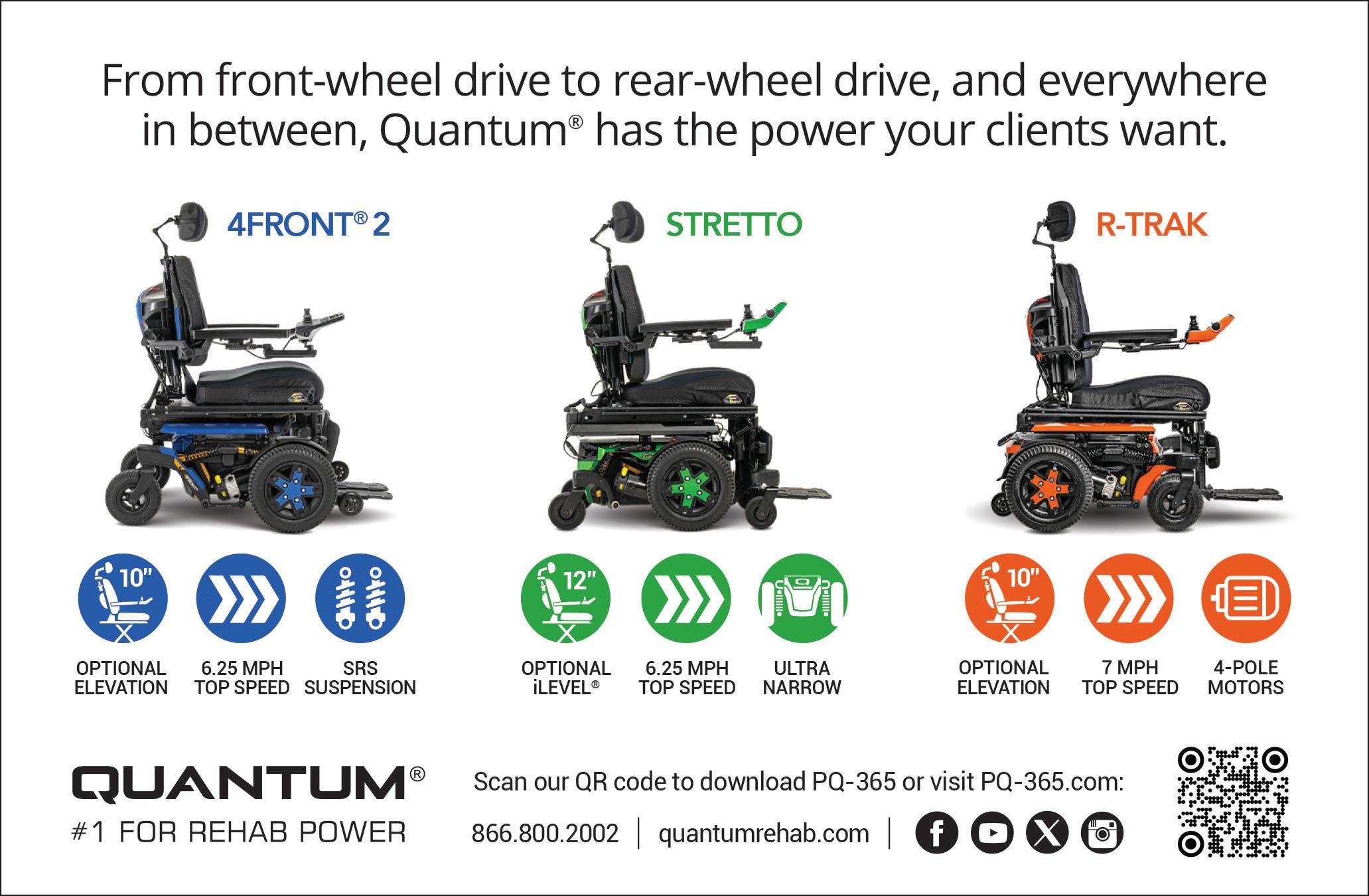
Written by: ANDREA VAN HOOK, RESNA EXECUTIVE DIRECTOR
Check out the new on-demand webinars in RESNA Learn! All webinars offer the opportunity to earn 0.1 IACET CEUs and are free for members. The non-member registration fee per webinar is $45.
To purchase webinars, login to the RESNA website (https://www.resna.org/).
Click on the “Shop” icon in the upper left hand corner and search “On-Demand Webinars.” A list of new webinars is also available on the RESNA homepage in the main slider under “What’s New.”
• Unusual Barriers to Effective Pressure Relief for Clients with NeuroProgressive Disorders; presenter Amber L. Ward, MS, OTR/L, BCPR, ATP/SMS, FAOTA; 0.1 IACET CEU.
• Current Trends and Innovations in Adaptive Video Gaming; presenter Drew Redepenning, MD, BBME, ATP; 0.1 IACET CEU.
Also available are two “Tech Tuesdays” on-demand video product demos, for one contact hour each:
• The Future of Cooking in AT: Brava’s Smart Oven Technology
• Enhancing Accessibility: Innovations in Assistive Technology by Clevy and Alt (accessible computer keyboards and mouse)
Our next live webinar is September 18 at 12 p.m. ET. The topic is “Wheelchair Skills Assessment and Training: An Evidence-Based Approach,” and the presenter is R. Lee Kirby, MD, FRCPC. Dr. Kirby will be discussing the Wheelchair Skills Program, a set of free online low-tech, high-impact, evidence-based resources for the assessment and training of the wheelchair skills of users (with or without the assistance of caregivers) of manual wheelchairs, powered wheelchairs and motorized mobility scooters.
We are pleased to announce that the RESNA conference will join RehabWeek Chicago on May 12-16 in 2025. RehabWeek is a week-long event that brings together different conferences in the field of rehabilitation technology at the same time and place to foster cross-disciplinary communication and the development of relationships between different players.
RehabWeek includes common keynote lectures and other mutually organized sessions, such as panel discussions and poster sessions. In addition, each conference also organizes its own conference specific sessions. Attendees can freely choose which conference to attend at any given time. The RESNA conference will be May 13, 14 and 15, and will feature educational breakout sessions, the Developers’ Showcase, the Student Design Challenge and Student Scientific Paper Competition, the Awards Ceremony and the Annual Membership Meeting.
The call for submissions opens in early August. Please check the RESNA website for more details.
In conjunction with AMRG and U.S. Rehab, RESNA is launching a new program to help prepare rehab repair technicians to become certified Assistive Technology Professionals.
This one-year program combines assistive technology training and education with a guided mentor program. We are currently seeking volunteers to serve as mentors. ATPs in good standing who work for a supplier or manufacturer are eligible. ATPs must have a minimum of two years of experience. Mentors will receive training and resources and be required to meet with program participants one hour a month following a calendar of topics. Those selected will receive an honorarium for their time and commitment and will also be able to submit three contact hours per year for their recertification renewal. This is a fantastic opportunity to enhance your resume and give back to the industry. Please see the RESNA website for details or email me directly at execoffice@resna.org
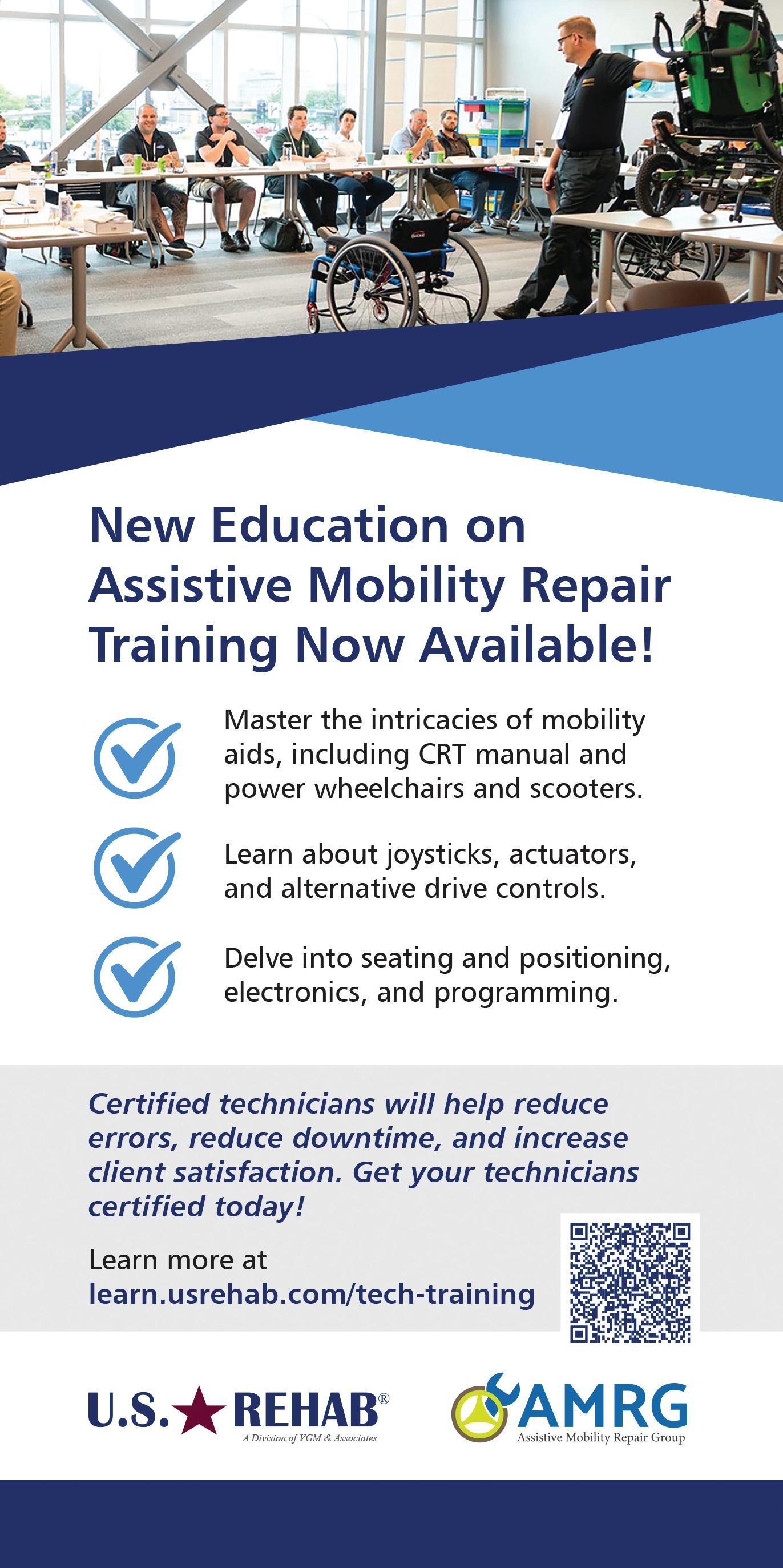
RESNA members recently voted in the annual board elections for officers and board members. Starting their terms on August 1, 2024, are:
President (2-year term): James A. Lenker, PhD, OTR/L, FAOTA, RESNA Fellow
President-Elect (2- year term): Rita J. Stanley, RESNA Fellow
Secretary (2-year term): Alisa Brownlee, ATP, CAPS, CLIPP, WSP
Board Member (3-year term): Krista Best, PhD
Board Member (3-year term): Julie Faieta, PhD
Board Member (3-year term): Marta Figueiredo, OTR/L
RESNA thanks Edward Giesbrecht, Daniel Cochrane, Heidi Koester, Maureen Linden, Tara Chay, and Gabrielle Kowalski for their board service.
Andrea may be reached at EXECOFFICE@RESNA.ORG

Andrea Van Hook is executive director of RESNA. She has over 20 years of experience in nonprofit association management. She lives and works in the Washington, D.C., area.
Written by: ANNA SOKOL, RN, MN, BSCN, BSCKIN, WOCC(C)

The industry of assistive technology and mobility provision is fortunate to have a very keen group of professionals working as a team. Although we may not be physically working in the same building, we rely on each other while achieving a common goal – providing necessary equipment for a person in need.
A clinician assesses a person and prescribes the necessary wheelchair and seating. A vendor sets up and provides equipment for trial and dispenses the finally agreed upon products. Technicians are at the core of know-how and require proper measurements for the appropriate set-up of the wheelchair system. Funding agencies review the submissions and make determination about the approvals. When everything goes smoothly, a manufacturer receives an order for a product and ships it to the customer.
One of the most challenging steps in the above process is the decision about which product(s) to consider. A large vendor may have as many as 10 different manufacturers of the same category of products to choose from. And each manufacturer may have 10 different product options. Sometimes, the price is the deciding factor, and nothing else matters. But other times, when clients asks for a quality product that is durable and works as designed. But other times, when clients ask for a quality product that is durable, they may ask if this product was tested. If it was, which guideline or method was followed? Is there a certain standard that all the products should pass? Many equipment providers wonder if the tests matter at all.
We interviewed a person who dipped her toes in the waters of the ISO Standards. Anna Sokol, RN, MN, BScN, BScKin, WOCC(C) is the clinical education specialist working for Motion Concepts, a manufacturer of seating and power positioning systems. She is involved in the Work Group 11 of ISO/TC 173/SC1, focusing on Wheelchair Seating Standards.


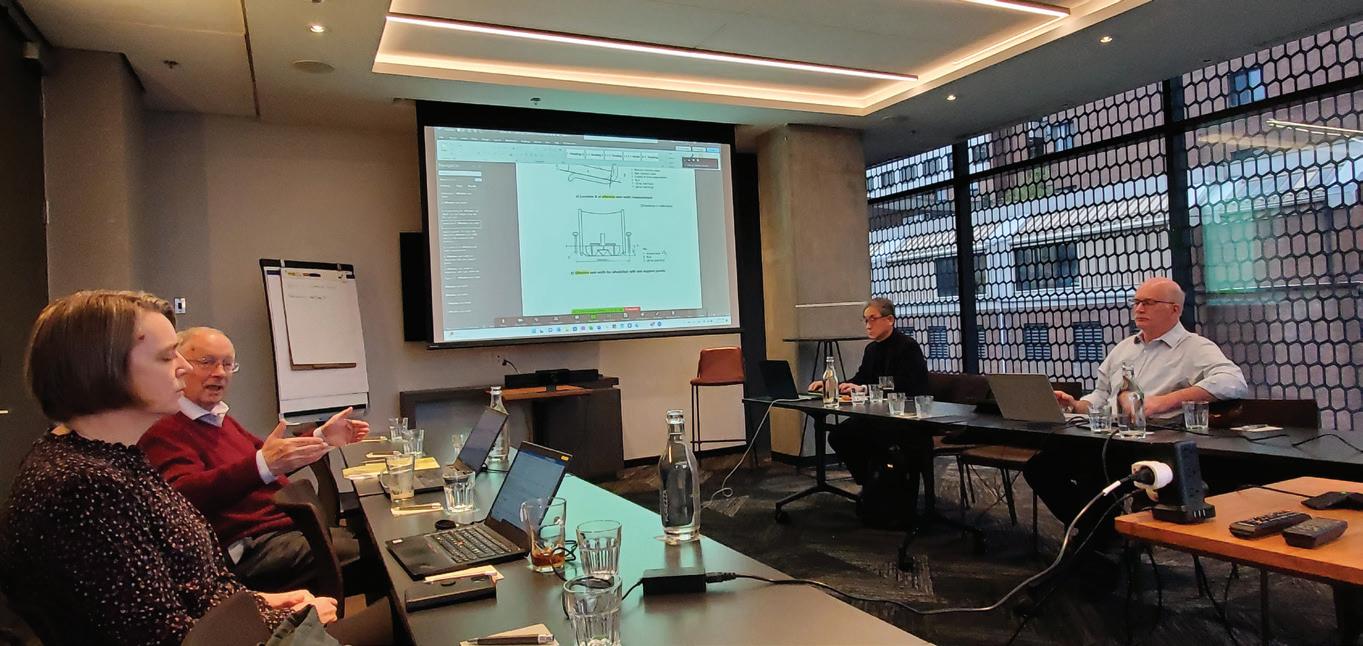
Simply put, if the product is tested, we know that its design was checked for durability, safety or certain intended purpose and performance. As an example, if a wheelchair cushion is designed to offer immersion and envelopment, it would be great to know it was tested following methodology specified in ISO 1684012:20211. Following a standardized way of testing assures everyone that it was not just some made-up test that the product maker came up with “in house” for marketing. Standards create an even playing field for manufacturers and service providers.
For a manufacturer, standards set the foundation for product development and innovation. Good product development combines creatively addressing a need while adhering to accepted product performance standards. The result is a product that meets the end user’s needs while being reliable and safe. Wellwritten standards do not hinder
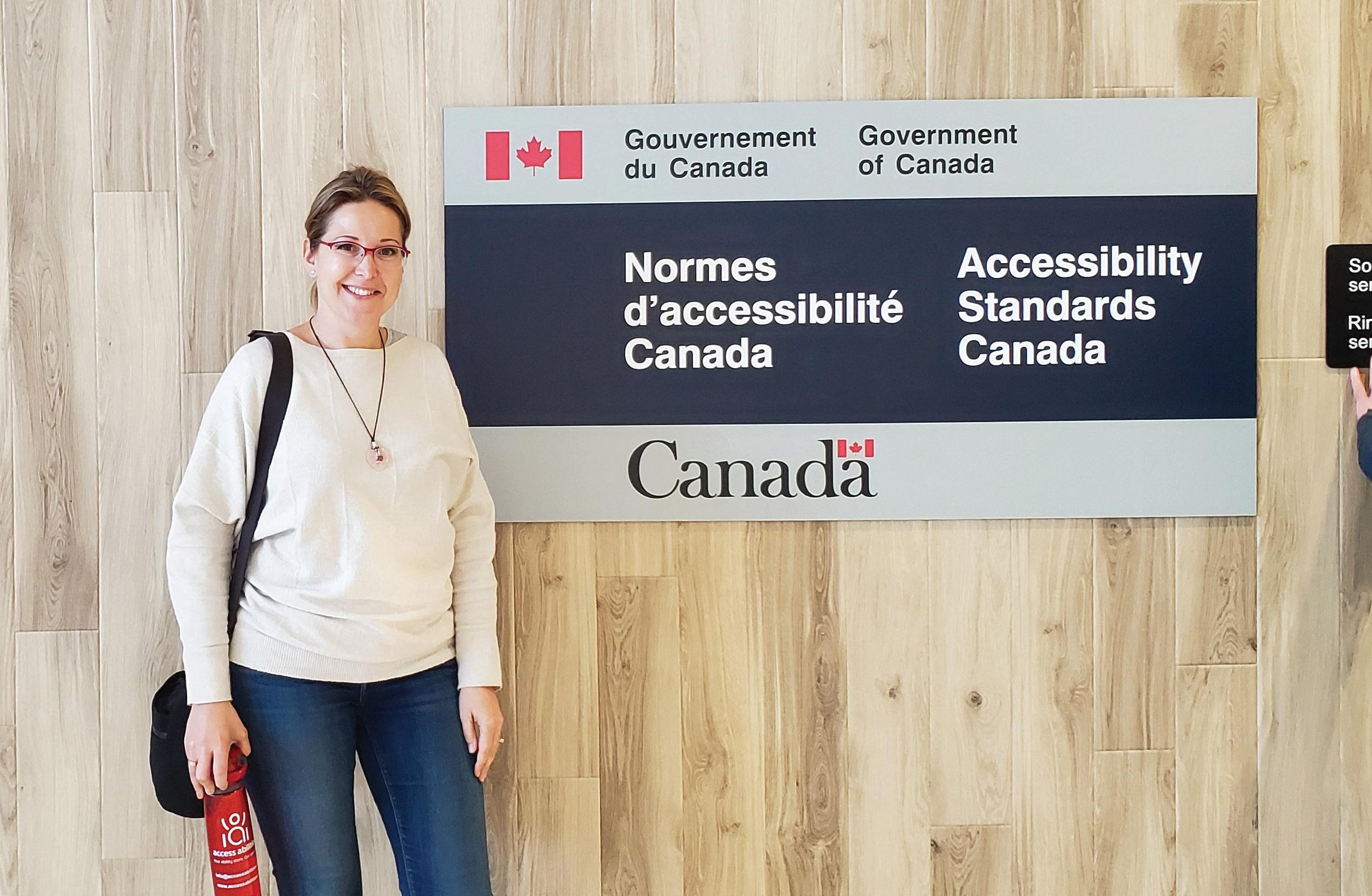
DIRECTIONS CANADA
(CONTINUED FROM PAGE 47)
innovation. On the contrary, standards are constantly reviewed and revised, if necessary, to reflect the latest technological developments. They are not restrictive or prescriptive. But very often, funding organizations or regulatory bodies can adopt a standard for their purposes and establish minimum performance for products or services.
There are usually no “pass” or “fail” guidelines in the standards. However, funding agency can stipulate a certain ‘pass’ criteria for products to be funded. In the United States, RESNA Standards may be mandatory for some funders. In Europe, some countries have a list of European Standards that manufacturers must comply with. These adopted standards could be derived from the ISO or from other National Standard bodies. As a manufacturer, we strive to test our
product's to as many applicable standards as possible, to ensure the greatest market potential. So, understanding the standards and their relevance and nuances is critical to a products success.
No, there are ISO Standards that cover processes and services, too. I like this passage taken from the ISO website (https://www.iso.org/standards.html): “ISO Standards are internationally agreed by experts. Think of them as a formula that describes the best way of doing something. It could be about making a product, managing a process, delivering a service or supplying materials – standards cover a huge range of activities. Standards are the distilled wisdom of people with expertise in their subject matter and who know the needs of the organizations they represent - people such as manufacturers, sellers, buyers, customers, trade associations, users or regulators.”

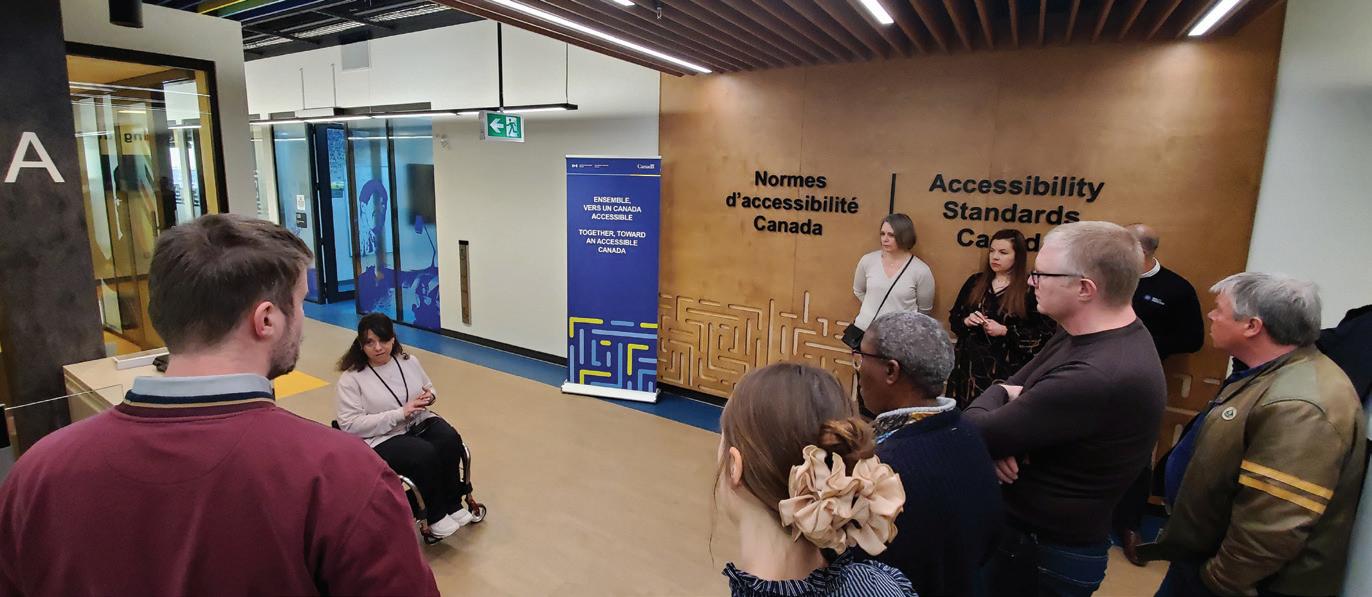

ISO/TC 173 is the subdivision of the ISO group of technical committees for assistive products. ISO/TC 173/SC1 is the name of the subcommittee focusing specifically on wheelchairs. Under this umbrella, there are several work groups (WGs): WG 1 Test methods; WG 6 Wheelchair restraint systems; WG 10 Requirements and test methods for electro-technical systems for wheelchairs; and WG 11 Wheelchair Seating.
International Standards are developed for the benefit of the international community. The ISO is a non-government organization that brings together experts from around the world to put together documents known as ISO Standards.
The goal of standard development is to offer a resource that may be helpful to someone looking for guidance on various matters. If experts from one country make significant progress in a certain area, learnings may be incorporated into the applicable International Standard. This way, others don’t need to re-invent the wheel.
Standards offer frameworks for the development of safe and reliable products and services. Wheelchair and Wheelchair Seating Standards in particular strive to guide the best ways that wheelchairs, wheelchair seating (backs and cushions) and positioning accessories can be measured, tested, described, discussed and applied. Creating a common terminology is a critical component, so that everybody is on the same page. The concepts described in
CONTINUED ON PAGE 50
DIRECTIONS CANADA
(CONTINUED FROM PAGE 49)
standards and the terms manufacturers and other stakeholders use to describe their products should be consistent and clear to everyone. For example, one of the documents currently under review is ISO 16840-12, which specifically focuses on terms and vocabulary.
As the world around us constantly changes, so do the standards. Therefore, the work related to standards review and revision is continuous and never-ending. As innovative wheelchairs and wheelchair seating products become available, they often challenge the old ways of looking into their properties and features. New knowledge in health sciences provide new insights into the ways the human body and tissues react to external forces and new ways we can look into these interactions. Developments in biomechanical engineering and new technologies may offer new tools for product development or new ways of testing product performance. Even new geopolitical trends may spark the need to look at services related to wheelchairs. Any of the above may trigger the need to revise the existing standard or to draft a new one.
Contributing to the development of Wheelchair Seating Standards, members of WG 11 come from different countries and backgrounds. We have representation from the United States, England, Portugal, Denmark, Japan, Australia, Germany, etc. There are engineers, academics, manufacturers, clinicians and representatives of the governing bodies and funding agencies. Despite a large membership, there are always more people needed. New members are always welcomed. When an issue is being looked at from different points of view, the Wheelchair Seating Standards become relevant to more audiences.
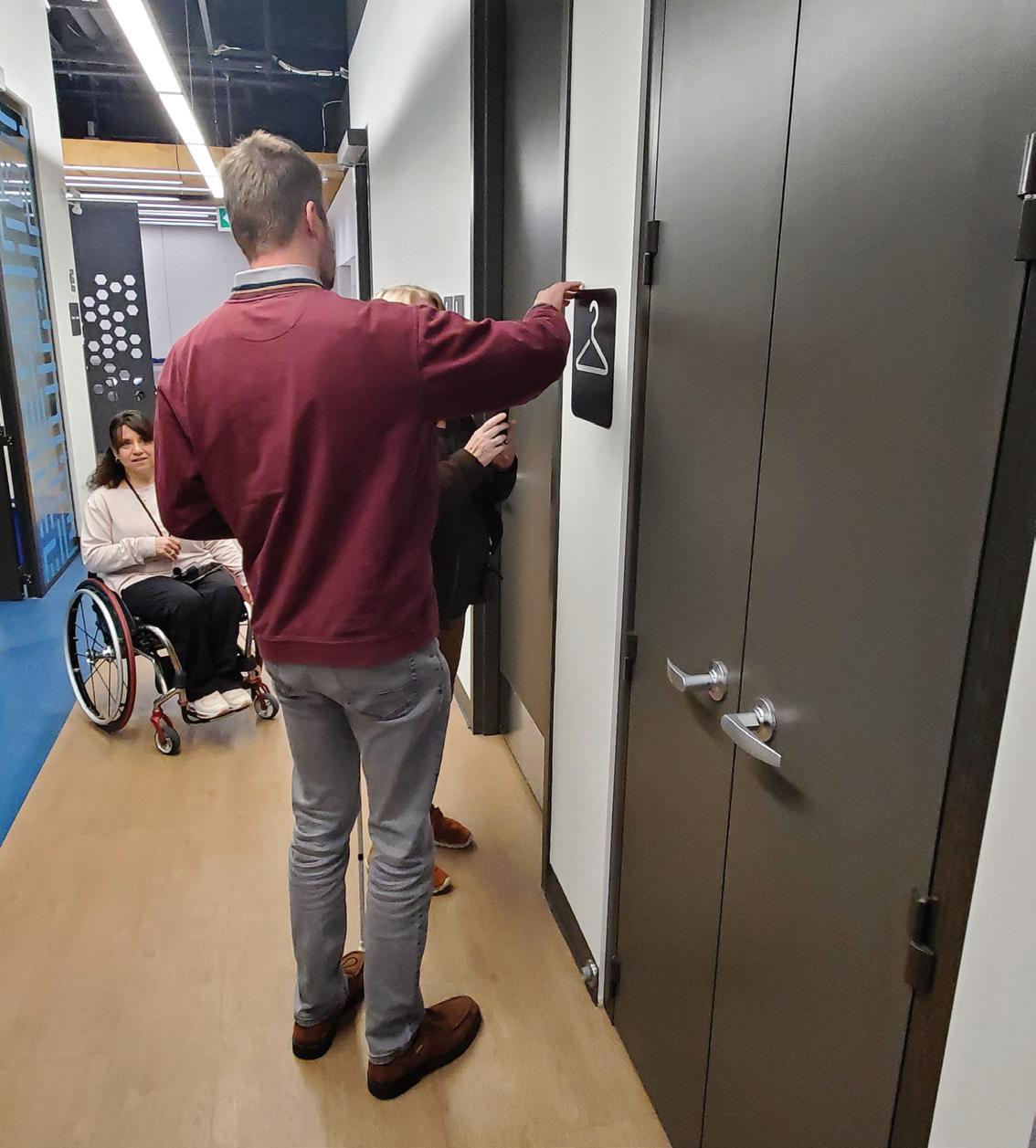
I often hear people asking if ISO Standards are mandatory. The answer is no, they are not. ISO Standards are voluntary, and in many instances, there is no “pass” or “fail” criteria. However, it should be noted that a voluntary standard does not replace national laws or regulations, which take precedence.
Certain funding agencies, or Regulatory Authorities such as the U.S. Food and Drug Administration, Health Canada and European MDR, may require certain standards (ISO and otherwise) to be mandatory within their jurisdiction depending on the type of product/device. Medical devices are regulated on a risk-based classification system, in which the higher the risk of the medical device/product, the more stringent the design controls, and the more likely there is to be mandatory standard compliance. Medical device regulations in Canada and Europe categorize products into four different classes (Canada: Class I, II, III, IV and EU: Class I, IIa, IIb, III), while the U.S. uses a three-tier classification system (Class I, II, III).
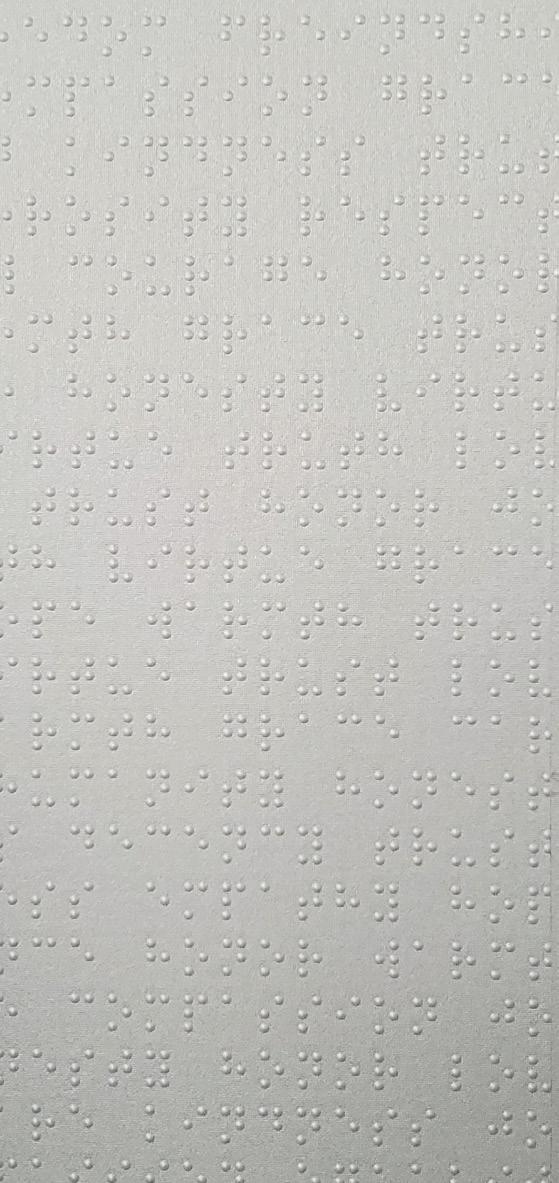
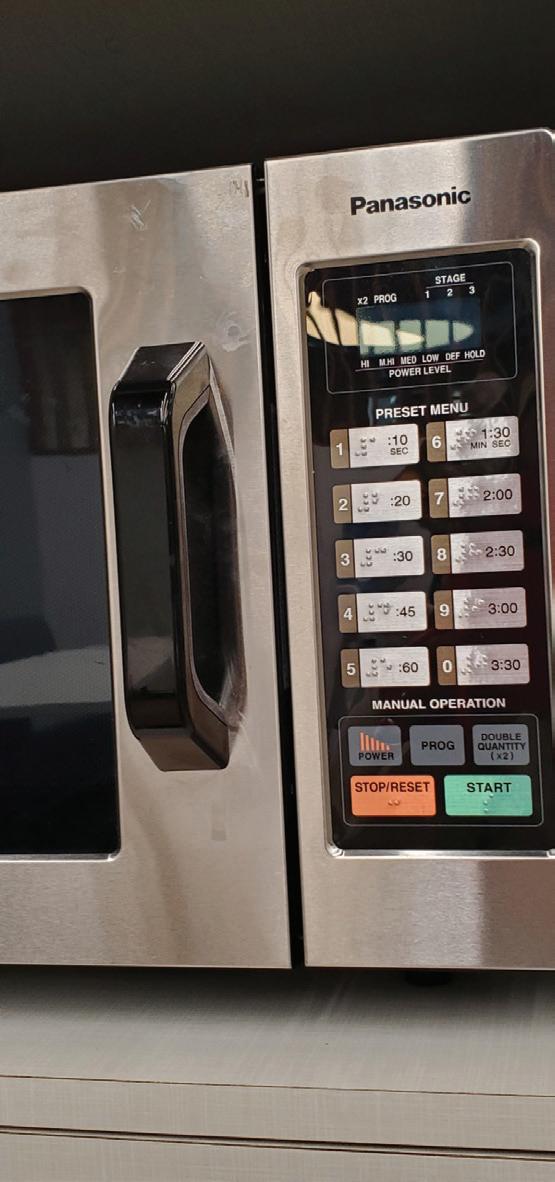
As a general rule, each Regulatory Authority defines a Class I product as a lower risk device. Although, how a particular product or device gets classified can vary within each jurisdiction. For example, manual wheelchairs, wheelchair seating (backs and cushions) and positioning accessories are categorized as Class I devices. Whereas power wheelchairs and power positioning systems are categorized as a Class II device in the U.S. but remain a Class I device in Canada and Europe. This difference in classification can introduce additional design control requirements for the product manufacturer, which in turn can introduce more mandatory standard compliance.
Regardless of the device classification, the use of voluntary ISO Standards becomes increasingly beneficial when selling comparable medical devices in the North American and European marketplace. Standardized test methods can provide assurances that a finished device meets a measurable level of performance, safety and effectiveness, which can in turn be compared across various similar products. In addition, for the consumer, it communicates that the company is taking their product quality seriously.
No, these are two different organizations. Although there is currently work underway to harmonize ISO Standards and RESNA Standards as much as possible, differences exist.
There are current examples where RESNA Standards and ISO Standards are considered comparable (e.g. ISO 16840-4:20093 and RESNA WC204). On the other hand, the ISO 7176 series ISO Standards and RESNA WC-1, WC-2 Standards for wheelchair testing, which are commonly compared, contain many sections that are aligned by their title and scope, however, differences in test methods do exist and they are not completely interchangeable.
The RESNA Assistive Technology Standards Board (ATSB) is the U.S. Technical Advisory Group to the American National Standards Institute (ANSI) and has been an accredited American National Standards Developer since 1989. The RESNA ATSB and Committees serve as the U.S. Technical Advisory Group (TAG) to ISO/TC 173 (Assistive Products Technical Committees) and ISO/TC 173/SC1 (Wheelchairs Subcommittee).
One standard is not necessarily more important than the other, but one may be more applicable.
Before testing any product, it is important for an organization, manufacturer and professional to establish which jurisdiction(s) they intend to sell the product/ device in, and to make certain that the applicable Medical Device Regulations are reviewed, to determine how the product is classified.
If the product is destined exclusively for the North American market, then the RESNA Standards would
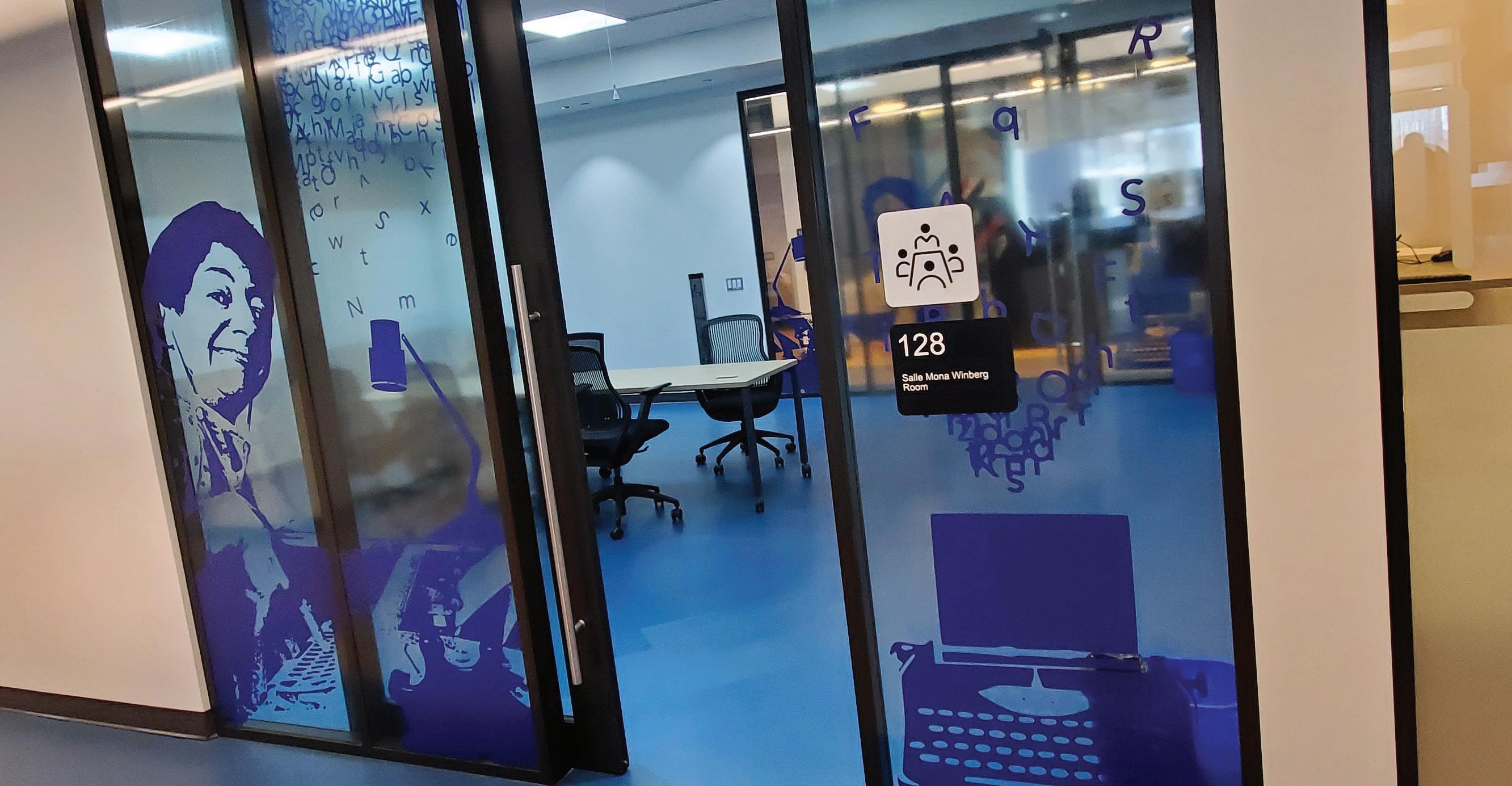
DIRECTIONS CANADA
(CONTINUED FROM PAGE 51)
be acceptable. However, if the intention is to sell the product in Europe, the RESNA Standards will not be recognized in most instances, and retesting to a corresponding ISO Standard becomes necessary. As RESNA and ISO become harmonized, this will become less of an obstacle.
It is also important to note the different jurisdictions, like the FDA, maintain a list of “recognized consensus standards.” These lists are regularly maintained and may identify multiple acceptable test standards for a specified device. As an example, the FDA recognizes sections of the ISO 7176 wheelchair test standards, as well as the RESNA wheelchair standards.
I had the privilege of being a member of Wheelchair Seating Work Group 11 over the past few years. This work presented a steep learning curve for me
personally. It definitely expanded and deepened my understanding of the world of product development and testing. At first, it was very hard to understand the rationales and terminology used in some standards. It took me some time to learn basic engineering terminology. I remember joking that I never thought that my high school physics would come handy.
As a clinician, I question each standards’ relevance to the clinical world. Asking “so what?” keeps me grounded in the realities of daily work with providers and prescribers of seating. If we know that a certain wheelchair back went through 16840-3 Static, Impact and Repetitive loads test, does it help a clinician in product selection?
Sometimes I challenge the standards and suggest revisions that include explanatory notes. It is very reassuring to see the language of 16840 series becoming more clinical lately. As more rationales are provided, it becomes easier for a non-engineer to understand why certain things matter or should be done a certain way.
Human interaction with the product is extraordinarily complex. For one person, envelopment is a priority, for another stability. Some clients have multiple care goals. But each standard looks at different
aspect independently. Because the only way to ensure the test is reliable and repetitive is to remove the confounding variables. This may be particularly challenging for me as a clinician to accept. A clinician (prescriber) has to complete a benefits/risks analysis for a client if the product in consideration does not address all the priorities. In my clinical educator role, I always emphasize a clinician’s critical thinking. Standards’ interpretation are at the forefront when I discuss various aspects of seating products with clinicians. But I always stress that full client assessment and collaboration with other disciplines are required to address all the aspects of client’s lifestyle, health, goals and seating needs.
Aside from contributions to other documents, this year I have a chance to participate in the development of a Standard for Seating Assessment. One of the main goals would be to communicate to the broader community that a wheelchair is not just a seat on wheels. People come in different shapes and sizes, with different abilities and limitations, and their conditions are constantly changing. It is important to raise awareness about the importance of seating assessment, the value of an optimally fitted wheelchair and seating, and the risks associated with the wrong set up. While we have a lot of expertise and specialized assessment tools available through renowned universities, many parts of the world may simply not have access to the specialists. In this standard, we will try to provide a minimum data set that everybody could use. We will also list various assessment tools and additional resources.
Many people have asked me what a nurse is doing in the wheelchair seating group. It is often assumed that wheelchair seating belongs to the world of occupational therapists and physiotherapists. Yet, I believe that every nurse should learn about wheelchairs and wheelchair seating. I am not saying that nurses should provide specialized comprehensive seating assessments; however, a nurse should recognize when something is wrong. It is the nurses who are at the bedside the most; it is the nurses making home visits most frequently; it is the nurses who are eyes the and ears of the health care system. Nurses are also the ones advocating for their clients and the ones triggering referrals to other specialties.
On a personal note, going through an injury recently exposed me to an eye-opening experience. While on vacation, I ended up using a wheelchair provided by the hotel. Several people stopped to comment on the wrong size, set up, seating, etc. They were right, I was “tortured by the wheelchair” (the expression I started using after this experience). When I asked where they learned so much about wheelchairs, it turned out they were nurses, and their nursing school had wheelchairs as part of the mandatory curriculum.
There would be value in the availability of nursing wheelchair curriculums. When a nurse looks at the wheelchair seating with all the background knowledge about the client’s health, priorities may be very different from the OT or physical therapist. In a simplified example, the OT may be looking through the occupational capacity lens. PT may be looking at the mobility, ROM, and strength gaining. A nurse would be looking at pain levels, medication management, pressure injury, adjustments necessary to the feeding tubes, dressings, catheters, incontinence products, etc. We all want to make sure the person using wheelchair seating products is safe. Wouldn’t it be wonderful if seating assessment was incorporated into the postsecondary curriculums of nurses, PTs, and OTs around the world as a mandatory program component?
As a clinician, my view on standards is biased toward clinical value and their relevance to the daily practice of the wheelchair seating prescribers. In my educator role, I often explain what immersion, envelopment, shear, pressure, friction and other concepts are. Explaining how cushion design aims to reduce external risk factors often brings me to the discussion on how different product properties are tested. As soon as I mention the tests we perform
CONTINUED ON PAGE 54
DIRECTIONS CANADA
(CONTINUED FROM PAGE 53)
in our laboratory and the ISO tests methods we use, clinicians feel that we enter a “foreign land.” Very often, the engineering terminology puts a clinician to sleep. So, effective knowledge translation becomes critical. I like to use simple words, a lot of pictures and videos in my presentations. Having worked on some ISO documents, I understand that standards require interpretation for the clinicians. I am happy to share that thanks to many Wheelchair Seating Work Group 11 members with clinical backgrounds, it is now easier to interpret the 16840 series. There are even couple of standards that I now refer to as my favorite ones –16840-9 Technical guidelines for the use of interface pressure mapping for seating in the clinical setting and 16840-14 Terminology and concepts related to managing external forces to maintain tissue integrity.
THE ISO/TC 173/SC1 WORKING GROUP 11 MET IN OTTAWA IN APRIL 2024 AND WAS HOSTED BY ACCESSIBILITY STANDARDS CANADA. ANYTHING INTERESTING YOU WOULD LIKE TO SHARE?
This was a special conference for me and my colleague, Ivan Samila, because we attended in person. The meeting was hosted in Ottawa, Ontario, Canada, by the Accessibility Standards Canada. Aside from working with the Wheelchair Seating group, we also learned about developments in other committees. We were also invited for a half-day meeting at the ASC headquarters in Gatineau. The organization was established four years ago in response to the assent of Accessible Canada Act, 2019. We got a special tour of the building and learned that nothing was left to chance during the set-up of the offices. ASC headquarters display an exemplary space with maximum incorporation of various accessibility features. Diversity and inclusion are the guiding principles and hold a special value in this unique office space where 50% of employees have unique accessibility needs.
We were shown a wardrobe closet that was designed with wheelchair users in mind. The choice of colors throughout the hallways was purposeful, to help people with partial vision and cognitive deficits. Some ceiling tiles had an educational purpose, providing examples of color contrasts, fonts and text backgrounds that should not be used in printed and online informational materials. It was impressive to see special
configurations of office furniture, special arrangement of wall-mounted communication boards, individual ceiling light adjustments, Braille signage in English and French, wallpaper with motivational quotes in Braille, and even the voice-activated printer. The door spacing, distances between the office tables, widths of hallways, special kitchen set up, sound masking and dampening, and light-signaling fire alarm system – everything was carefully thought through. We noticed a special office arrangement for an employee with the service dog. Special non-slip floor surfaces, wide doors, safe door mounts and special door handles. Imagine our big guest group all fitting in the washroom fascinated with alarm buttons on different levels (one close to the floor, in case a person falls and needs to call for help) and examining the wall-mounted changing table. A transfer ceiling lift will soon be set up there as well.
We were introduced to the ASC Standards rule for committee composition where at least 30% of the members have a disability. This mandatory membership structure reflects ‘Nothing Without Us,’ the Canadian Accessibility Strategy for the Public Service of Canada. Notably, the meeting rooms were named after the Canadian disability activists and trailblazers like Salle Mona Winberg and Terry Fox.
One of the goals of ASC is “to achieve a barrier-free Canada by 2040.” Assistive devices break barriers for people with disability, but environment plays a key role in selection of the device. We have to work together to achieve success. The organization is developing accessibility standards, advancing accessibility research, and sharing information related to accessibility. While ASC only has the federal reach in Canada, they hope to inspire more inclusive building designs in all the jurisdictions right from the start. ASC also plays a role in guiding regulatory changes and introducing amendments to the building codes. Another priority for ASC is transport, and this includes air, railway travel, extra-provincial buses and ferries. ASC is working closely with Canadian Transportation Agency to improve accessibility regulations. This is where the wheelchair industry and transportation industry intersect, and collaboration with WG 6 Wheelchair restraints systems may be invaluable.
ASC Standards are accessible free of charge by anybody wishing to read a full document. Since the organization is relatively new, most of the standards are still in development. Yet, the drafts and descriptions of the scope of the documents are spelled out for the public: https:// accessible.canada.ca/centre-of-expertise With regards to the ISO Standards, access to the documents is for a fee. One of the topics during the Ottawa meeting was about easing access to the ISO Standards for the general public. Large institutions, manufacturers and universities have subscriptions and alerts allowing them to be up to
date on all the new ISO Standards and amendments. Unfortunately, the costs are prohibitive for the general public. While copies of the ISO Standards cannot be shared without the licensed access, some wheelchair and wheelchair seating manufacturers offer education webinars explaining what kind of tests their products were subjected to, how they performed and how these tests relate to selection of products for the clients. Manufacturers (their engineering and education teams) are actually a great resource for anybody curious about product performance. For people interested in a quick overview of standards, University of Pittsburgh offers some great fact sheets explaining how to interpret wheelchair seating performance resources: https://www.wheelchairstandards.pitt.edu/fact-sheets
IN LIGHT OF ALL OF THE ABOVE, ANY ADVICE FOR A VENDOR PROVIDING WHEELCHAIRS AND WHEELCHAIR SEATING PRODUCTS AND SERVICES?
My first piece of advice is always the same – choose who you are working with carefully. It is worthwhile spending some time and learning about the manufacturer. The company proud to offer quality products will also be proud to talk about their products being tested in accordance with ISO Standards and RESNA Standards. They will not shy away from sharing their certificates and disclosing the lab they use for the tests.
The second advice is to make a conscious decision to be up-to-date about the products. Annual trade shows are the best places to see what is new in one or two days. During CSMC (Canadian Seating and Mobility Symposium) and ISS (International Seating Symposium), the manufacturers have the most knowledgeable people at the booths. You can see and handle the latest products, ask any questions and don’t be surprised if the vice president, lead educator or even engineer will be the person providing an answer.
My last piece of advice is to seek education. It is often assumed that OTs and PTs prescribe wheelchair seating, because they learned about it in school. Unfortunately, very few post-secondary programs allocate sufficient time to the topics on wheelchair, seating, and mobility. Therefore, there are also many educators working for the manufacturers offering free courses on various topics important for client safety. Committing to continuous learning is a must for anybody with a life-long business success strategy. For individuals in the field, there are many specialty courses offered by the universities. RESNA Certification programs for Assistive Technology Professionals, Seating and Mobility Specialists, Rehabilitation Engineering Technologists are very comprehensive.
For businesses, obtaining iNRRTS memberships distinguishes the vendor as a company employing knowledgeable staff and caring about their reputation. Memberships also allow us to stay up-to-date on the latest regulations, products, funding approvals. Through iNRRTS, professionals working in the assistive technology industry get access to a high-quality webinar, education events and CEU articles.
REFERENCES
ISO 106840-12:2021 WHEELCHAIR SEATING- PART 12: ENVELOPMENT AND IMMERSION CHARACTERIZATION OF SEAT CUSHIONS USING A DUAL SEMISPHERICAL INDENTER.
SO 16840-1:2006, WHEELCHAIR SEATING- PART 1: VOCABULARY, REFERENCE AXIS CONVENTION AND MEASURES FOR BODY SEGMENTS, POSTURE AND POSTURAL SUPPORT SURFACES.
ISO 16840-4:2009, WHEELCHAIR SEATING- PART 4: SEATING SYSTEMS FOR USE IN MOTOR VEHICLES
RESNA WC-4:2017, VOLUME 4: WHEELCHAIRS AND TRANSPORTATIONSECTION 20: WHEELCHAIR SEATING SYSTEMS FOR USE IN MOTOR VEHICLES
CONTACT THE AUTHOR
Anna may be reached at ASOKOL@MOTIONCONCEPTS.COM
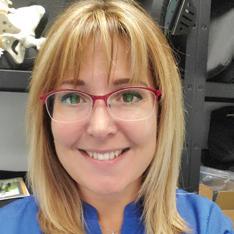
Anna Sokol, RN, MN, BScN, BScKin, WOCC(C) is a Clinical Education Specialist - Matrx ® Seating. Sokol has a background in Kinesiology and Nursing and is a Certified Wound Care Nurse and offers her expertise in client safety and quality metrics and has presented internationally on various topics, including Skin Protection, Fall Prevention, and Infection control. As a member of Motion Concepts team, Sokol contributes to product development, sharing feedback from clients and caregivers, and conducting clinical research on product designs. She is also a member of ISO/TC 173/SC 1/WG 11 Wheelchair Seating Standards Group. As an Educator, Sokol strives to create bridges between the clinicians and the equipment provision teams with a goal of improving the lives of those who require specialized Seating and Mobility solutions.
The following individuals renewed their registry with iNRRTS between May 23, 2024, and July 22, 2024.
PLEASE NOTE IF YOU RENEWED AFTER JULY 22, 2024, YOUR NAME WILL APPEAR IN A FUTURE ISSUE OF DIRECTIONS. IF YOU RENEWED PRIOR TO MAY 23, 2024, YOUR NAME IS IN A PREVIOUS ISSUE OF DIRECTIONS.
FOR AN UP-TO-DATE VERIFICATION ON REGISTRANTS, PLEASE VISIT WWW.NRRTS.ORG, WHICH IS UPDATED DAILY.
Aaron Mckenzie, RRTS®
Alan F. Bettencourt, ATP, CRTS®
Alicia Truebenbach, ATP/SMS, CRTS®
Angela Naranjo, ATP, CRTS®
Azby Farnet, RRTS®
Bennie G. Jones, ATP, CRTS®
Bernard Opp, RRTS®
Bradley Coughlin, RRTS®
Brennan Arbogast, ATP, CRTS®
Brent Manning, ATP, CRTS®
Brian Littlefield, ATP, CRTS®
Cacee Reuben, ATP, CRTS®
Carl A. Mulberry, ATP/SMS, CRTS®
Cary Marsh, ATP, CRTS®
Chad Jones, ATP, CRTS®
Charles Ackerman, ATP, CRTS®
Christopher Rogers, ATP, CRTS®
Christopher Kelly, RRTS®
Christopher Fortune, RRTS®
Colton Nelson, ATP, CRTS®
Connie Divine, ATP, CRTS®
Courtney Hauck, RRTS®
Crystal Lee, ATP/SMS, CRTS®
Curtis Noble, RRTS®
Cynthia D. Miller-Orahood, ATP, CRTS®
Daniel L Stephens IV, RRTS®
David Anderson, ATP, CRTS®
Dawn Ruth-Larson, ATP, CRTS®
Deborah Guglietti, RRTS®
Deborah J. Lazure, ATP, CRTS®
Desmond Wiles, ATP/SMS, CRTS®
Dustin Swartz, ATP, CRTS®
Eduardo Jimenez Garcia, RRTS®
Edward Bonk, PT, ATP/SMS, CRTS®
Eric Gilbert, RRTS®
Ethan McDonald, RRTS®
Felice Ioculano, RRTS®
Fernando Castillo, ATP, CRTS®
Garret Ebernickle, ATP, CRTS®
Gary Bourget, RRTS®
Gavin Dhanoi, RRTS®
Greg Newth, ATP, CRTS®
Hope Villines, COTA/L, ATP, RRTS®
J. Gregg Blanchard, ATP, CRTS®
James Larkner, RRTS®
James Mallach, RRTS®
James A. Golick, ATP, CRTS®
James C. Christy, ATP, CRTS®
James Z. Leddy, RRTS®
Jasmine Libarian, ATP, CRTS®
Jason Melms, ATP, CRTS®
Jason Simpson, ATP, CRTS®
Jay Lujan, ATP, CRTS®
Jean-Francois Cormier, RRTS®
Jeanne Hegg, ATP, CRTS®
Jeff Hager, ATP/SMS, CRTS®
Jeffrey Decker, ATP/SMS, CRTS®
Jeffrey B. Swift, ATP, CRTS®
Jeremy Kilgore, ATP, CRTS®
Jeremy Booker, RRTS®
Jody Mair, ATP, CRTS®
John Fullmer, Jr., ATP, CRTS®
Jonathon Sewell, RRTS®
Joshua Riemersma, RRTS®
Judy Taylor, ATP, CRTS®
Kathy Bondy, RRTS®
Keith A. Schwartz, ATP, CRTS®
Kevin Jones, MS, ATP, CRTS®
Kimberly F Cooper, ATP, CRTS®
Kori McLean, RRTS®
Kristin Maunula, RRTS®
Lois Brown, ATP/SMS, CRTS®
Lyndsey Nyland, RRTS®
Marc Suddarth, RRTS®
Marcus Page III, PTA, ATP, CRTS®
Mark Swanson, ATP, CRTS®
Mary Hitt Young, ATP, CRTS®
Matt Topf, ATP, CRTS®
Michael Collins, ATP, CRTS®
Michael Bobala, ATP, CRTS®
Michael Bissonnette, ATP, CRTS®
Michael Cheung, MScPT, RRTS®
Mitchell Koplowitz, RRTS®
Olugbemileke Kola Pacheco, ATP, CRTS®
Patrick Frey, ATP, CRTS®
Patrick R. Mazey, ATP, CRTS®
Paul Lamothe, RRTS®
Ray Cazalet, ATP, CRTS®
Ray Parsons, RRTS®
Raymond Filiatrault, RRTS®
Rebecca Jones, RRTS®
Richard Petersen, ATP, CRTS®
Robert Cooper, ATP, CRTS®
Robert McLean, ATP, CRTS®
Robert Lamarche, RRTS®
Roger Grant, RRTS®
Ronald Mack, ATP, CRTS®
Ronald Keith Hayes, ATP, CRTS®
Salvador San Juan, RRTS®
Sarah Moeller, ATP, CRTS®
Scott Leikala, ATP, CRTS®
Scott C. McGowan, ATP, CRTS®
Sean Jones, ATP, CRTS®
Stefanie Laurence, B.Sc. OT, OT Reg. (Ont.), RRTS®
Steven Shipley, ATP, CRTS®
Steven E. Williams, ATP, CRTS®
Thomas Ouimette, ATP, CRTS®
Thomas Connelly, RRTS®
Toby Bergantino, ATP, CRTS®
Trevor Gould, RRTS®
Vanda Obratov, RRTS®
Vincent Handrick, ATP, CRTS®
Wesley Dykstra, RRTS®
William Johnson, RRTS®
William Bingaman, PTA, ATP, RRTS®
Zachary Bennett, RRTS®
Zane Jacobs, ATP, CRTS®
The iNRRTS Board determined RRTS® and CRTS® should know who has maintained his/her registration in iNRRTS, and who has not.
NAMES INCLUDED ARE FROM MAY 23, 2024, THROUGH JULY 22, 2024. FOR AN UP-TO-DATE VERIFICATION ON REGISTRANTS, VISIT WWW.NRRTS.ORG, UPDATED DAILY.
Todd Miller, ATP/SMS Champaign, IL
Rustom E. Hallett, ATP Martinez, CA
Emilie Addy Ottawa, Ontario
Michael F. Peterlin, ATP Brooklyn Heights, OH
Anthony J. Soria, Jr. Countyside, IL
Ronald J. Seely, ATP Farmers Branch, TX
Robert Ford, ATP Pensacola, FL
Wayne Iba, ATP Anaheim, CA
Juan Carlos Torres Bellflower, CA
Justin Serafinus Medicine Hat, Alberta
Shelley Randall Ottawa, Ontario
Jennifer Erickson Prince George, British Columbia
Teresa Pyren, RRTS® Kitchener, Ontario
Eric Forster, ATP Montgomeryville, PA
William Alex Borthwick Nanaimo, British Columbia
David Regnier Sydney, Nova Scotia
Shane Davis, ATP Meridian, ID
Janice Lewis Ottawa, Ontario
Malcolm Kirkpatrick Perth, Ontario
Dino Padula Kelowna, British Columbia
Congratulations to the newest iNRRTS Registrants. NAMES INCLUDED ARE FROM MAY 23, 2024, THROUGH JULY 22, 2024.
Andrew Dwyer, RRTS® Medical Plus Supplies Round Rock, TX
Cortney Wyatt, RRTS® Adapthealth Catlettsburg, KY
Craig Hustler, RRTS® Dura Med Mobility Products Inc. London, Ontario
Dan Oganovich, RRTS® Better Healthcare Options Elgin, IL
Edwin Pabon, RRTS® Custom Mobility Largo, FL 33777-1502
Erin Fitchew, RRTS® National Seating & Mobility, Inc. Van Nuys, CA
Jaclyn Miller, RRTS® Macdonald's Home Health Care Vancouver, British Columbia
Jeff Apple, ATP, CRTS® Apple Independence Mobility LLC Cookeville, TN
Kara McCutcheon, RRTS® Motion Calgary, Alberta
Logan Graham, RRTS® Rehabilitation Equipment Professionals, Inc. Alexandria, VA
Micah Dettmar, RRTS® Hometown Healthcare Millbrook, AL
Michael Bidner, RRTS® HME Mobility & Accessibility Victoria, British Columbia
Nick Harmon, ATP, CRTS® Southern Mobility Specialists, Inc. Houston, MS
Odie Marie Stepp, ATP, CRTS® National Seating & Mobility, Inc. Knoxville, TN
Phillip Rollinson, RRTS® National Seating & Mobility, Inc. Chattanooga, TN
Timothy Houghton, RRTS® Adapthealth St Paul, MN
William Scarborough, RRTS® National Seating & Mobility, Inc. Chattanooga, TN
Congratulations to iNRRTS Registrants recently awarded the CRTS® credential. A CRTS® receives a lapel pin signifying CRTS® or Certified Rehabilitation Technology Supplier® status and guidelines about the correct use of the credential. Names listed are from May 23, 2024, through July 22, 2024.
Blake Faulk, ATP, CRTS® National Seating & Mobility, Inc. Broussard, LA
Claire Savoie, ATP, CRTS® Rehab Medical Inc. Baton Rouge, LA
Cynthia Bohlmann, ATP, CRTS® Avera Home Medical Equipment Sioux Falls, SD
Jeff Apple, ATP, CRTS® Apple Independence Mobility LLC Cookeville, TN
Jordan Henderson, ATP, CRTS® National Seating & Mobility, Inc. Wichita, KS
Joseph Cecchi, ATP, CRTS® National Seating & Mobility, Inc. Countryside, IL
Nick Harmon, ATP, CRTS® Southern Mobility Specialists, Inc. Houston, MS
Odie Marie Stepp, ATP, CRTS® National Seating & Mobility, Inc. Knoxville, TN
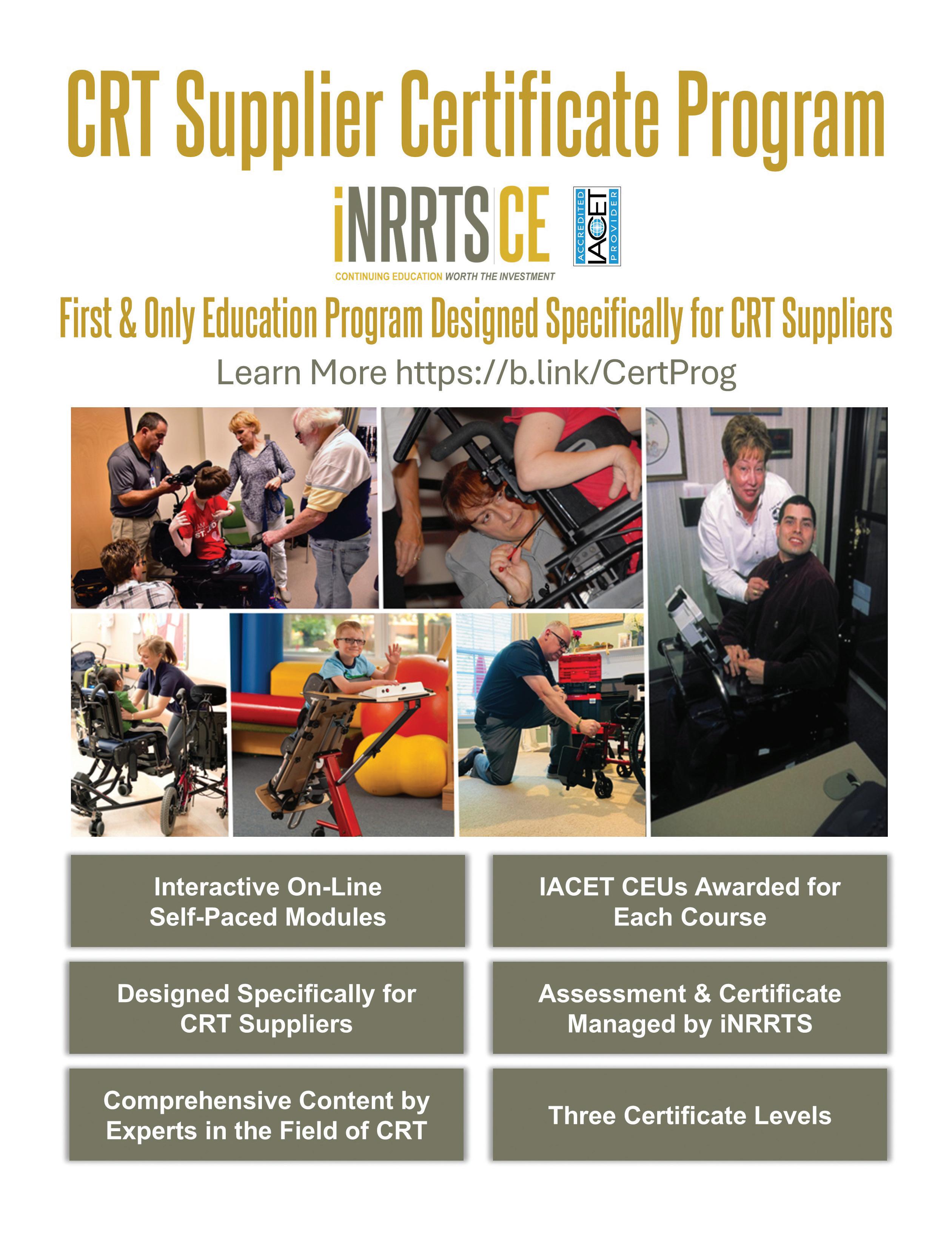
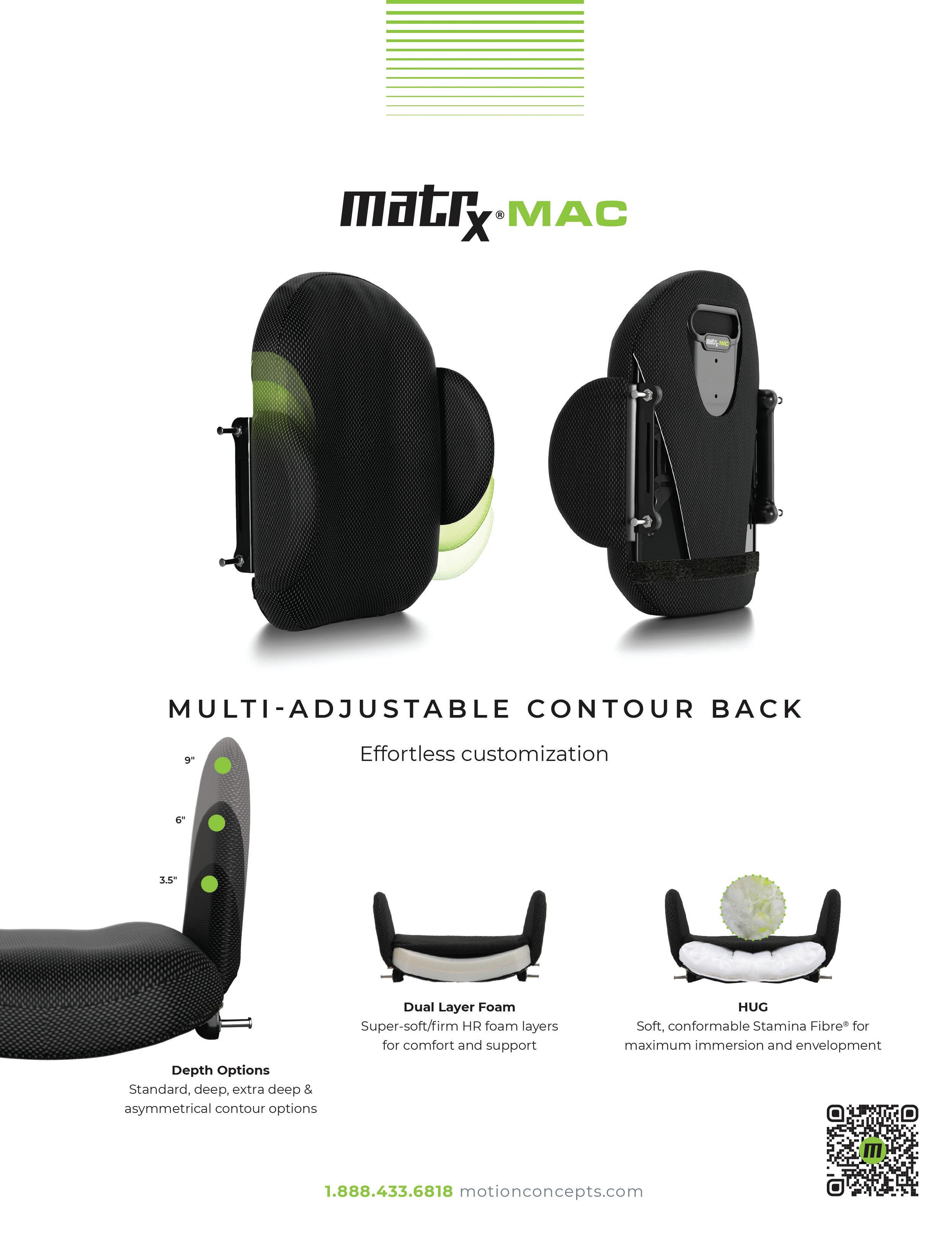

5815 82nd Street, Suite 145, Box 317
Lubbock, TX 79424
P > 800.976.7787
As Corporate Friends of iNRRTS, these companies recognize the value of working with iNRRTS Registrants and support iNRRTS’ Mission Statement, Code of Ethics and Standards of Practice.











